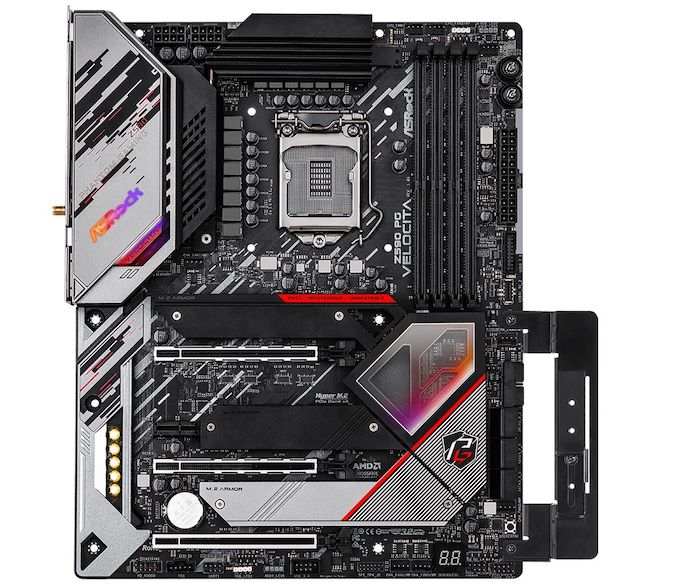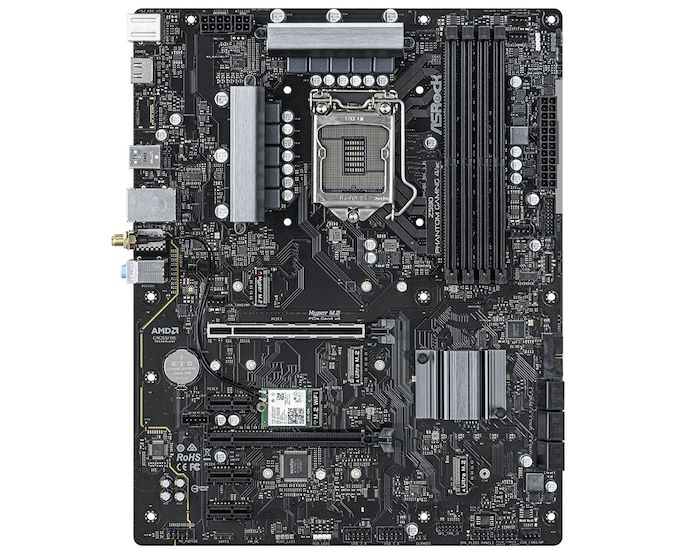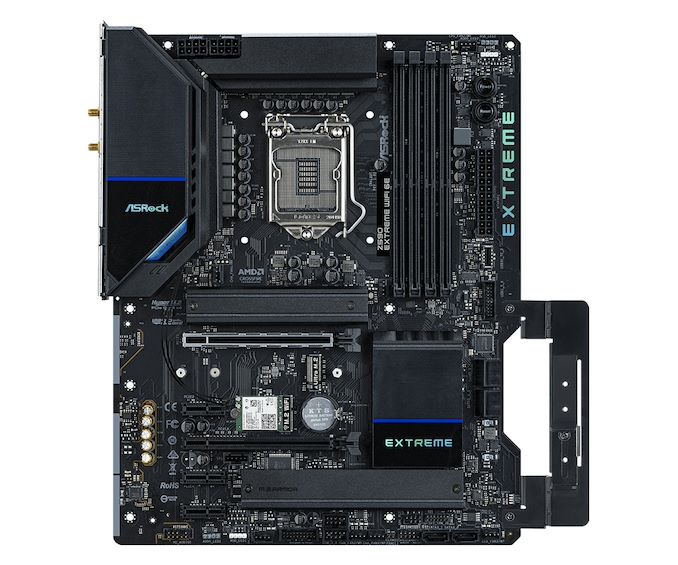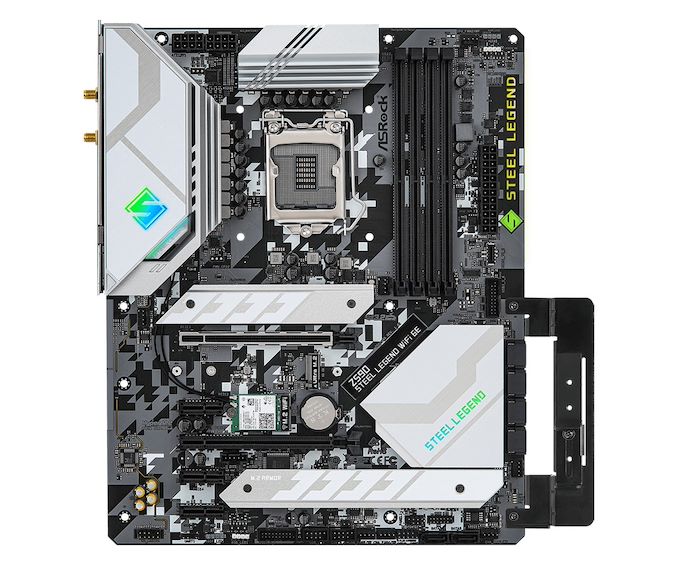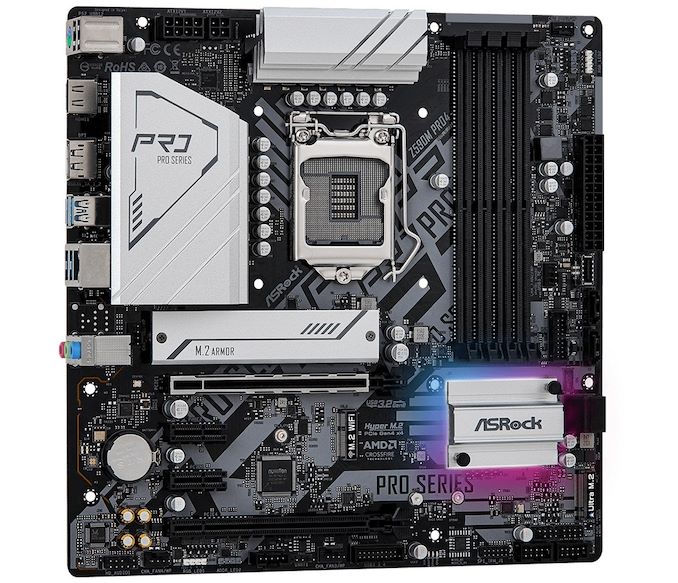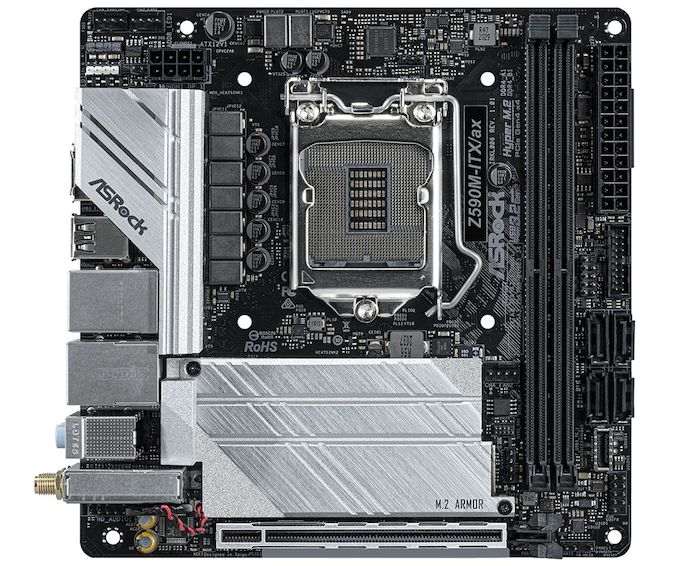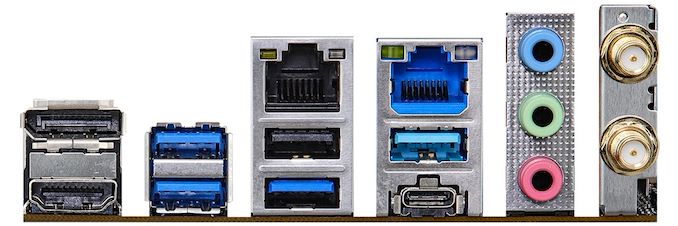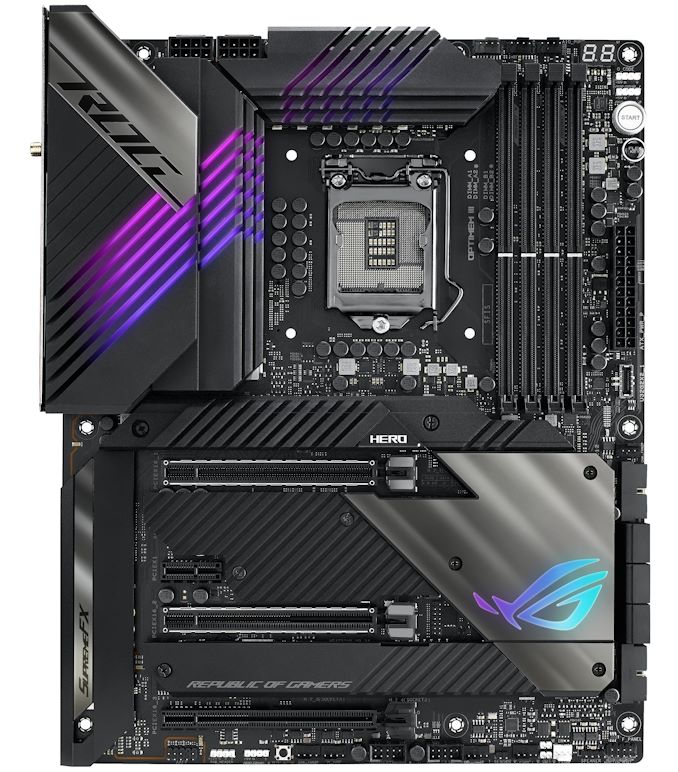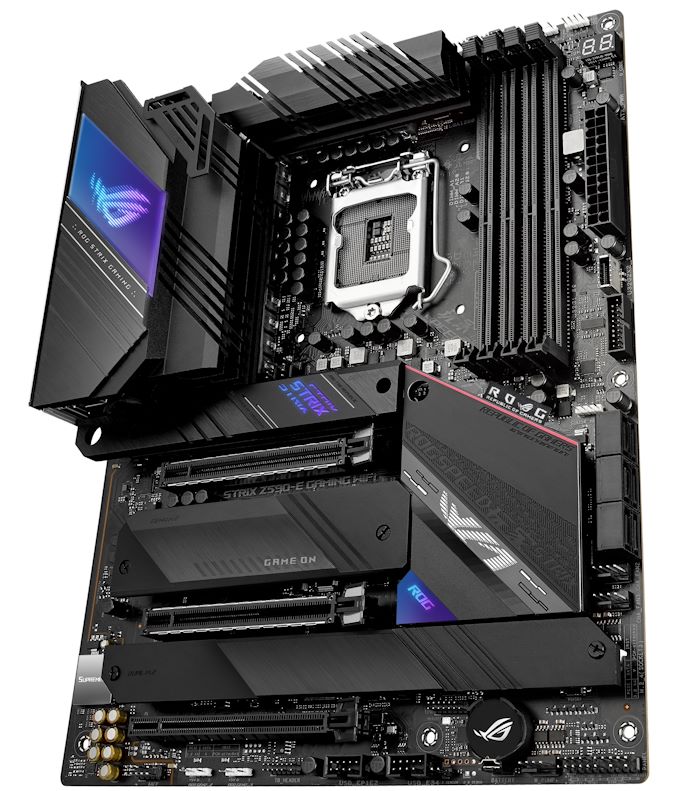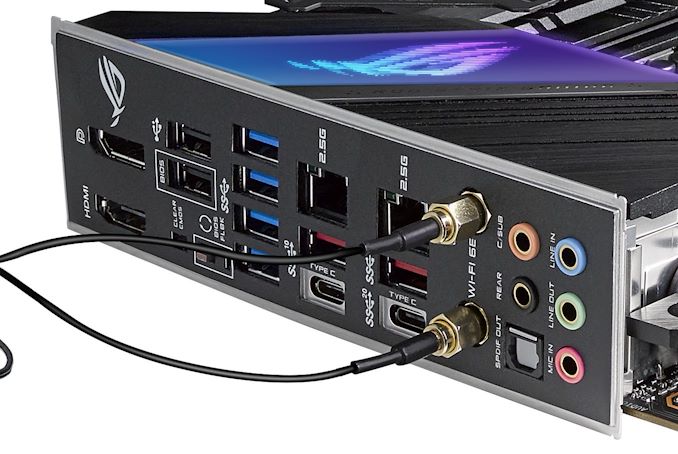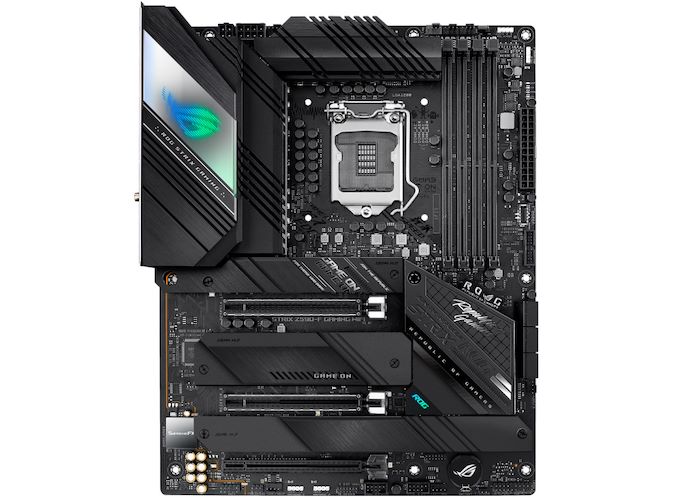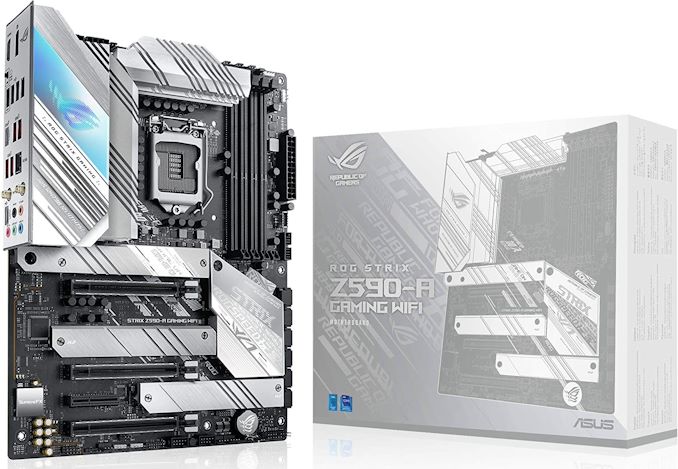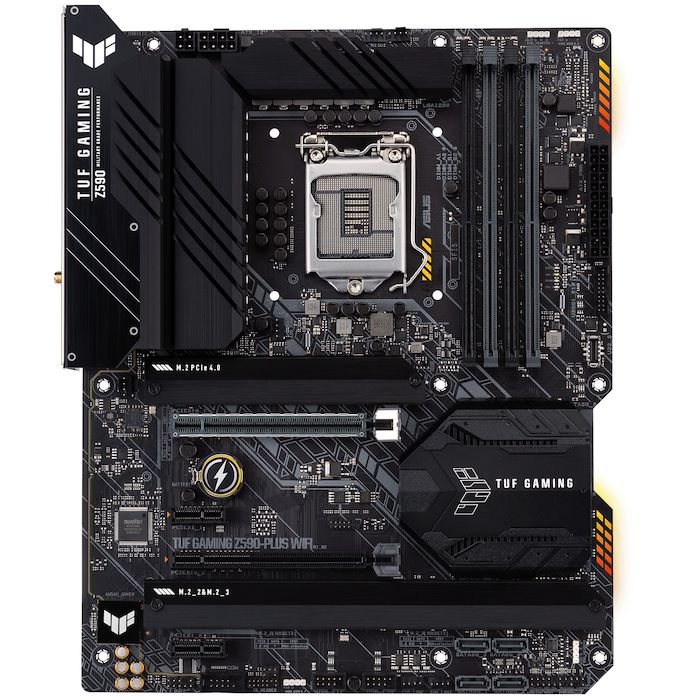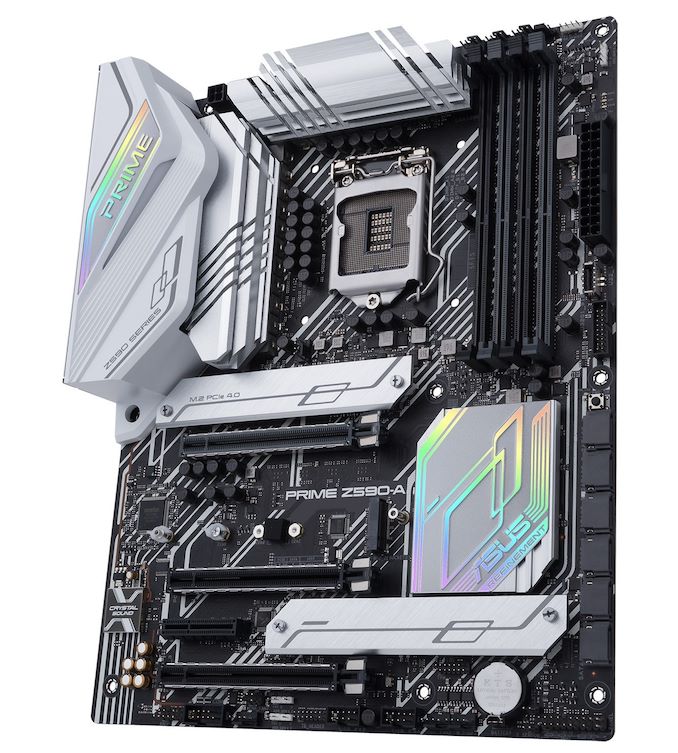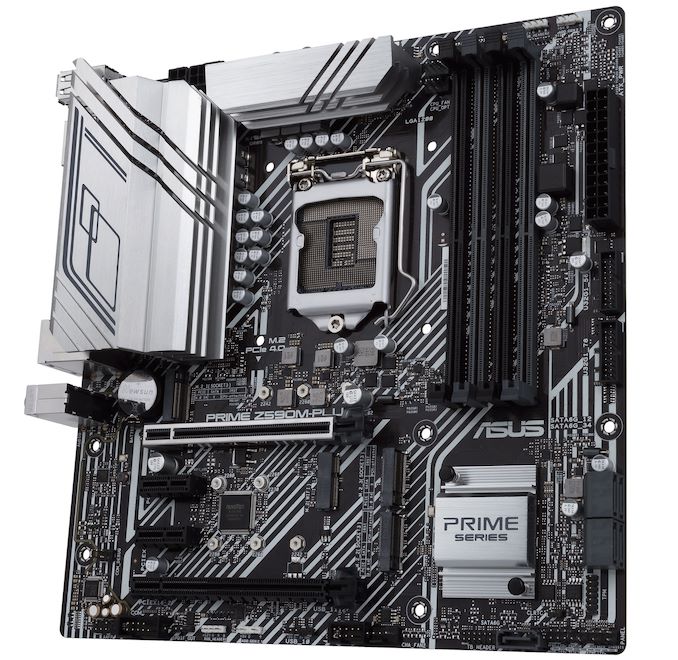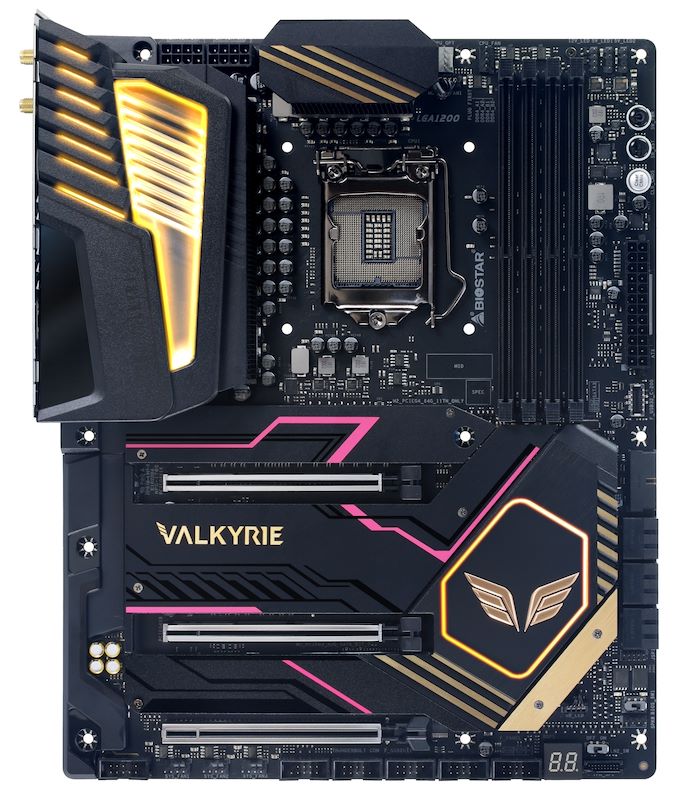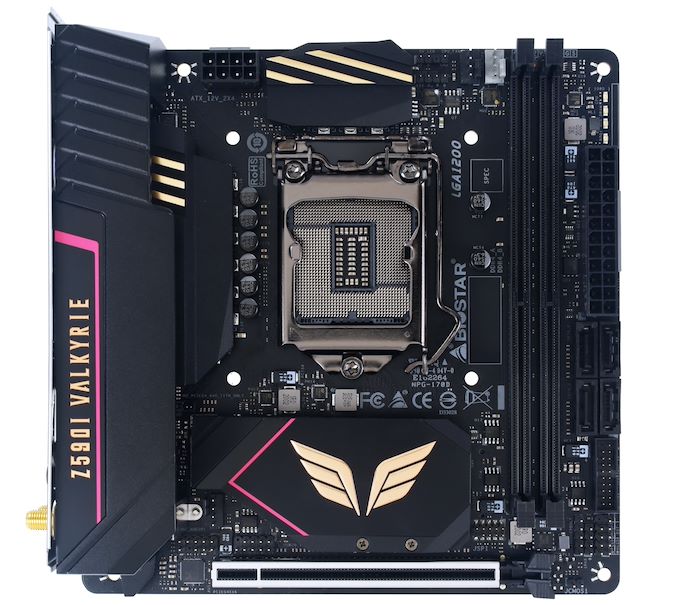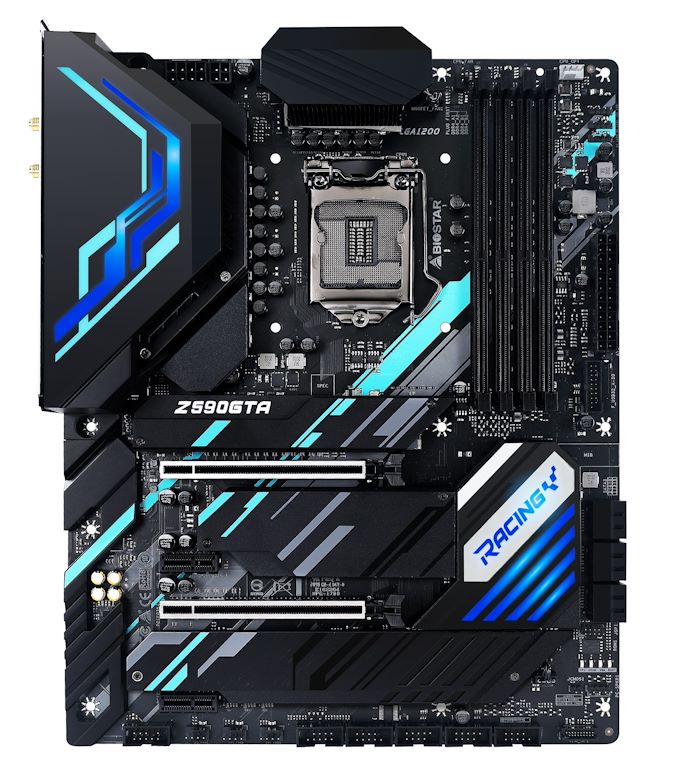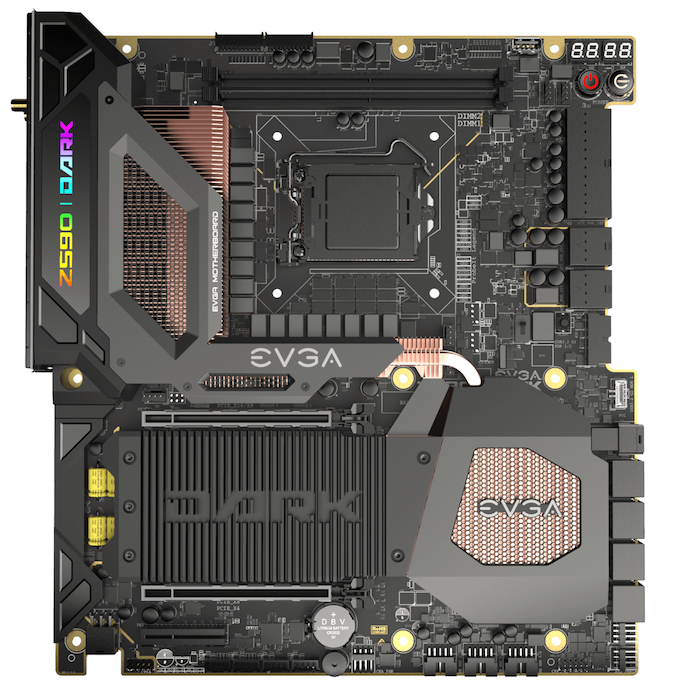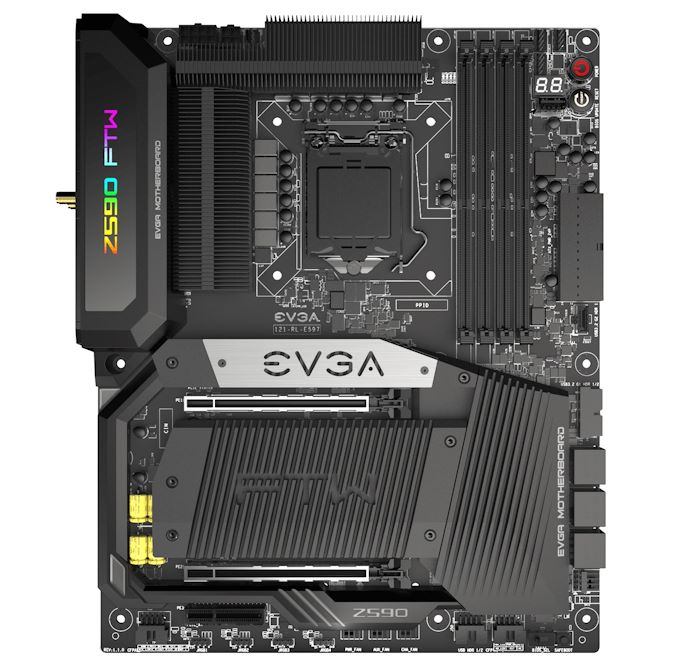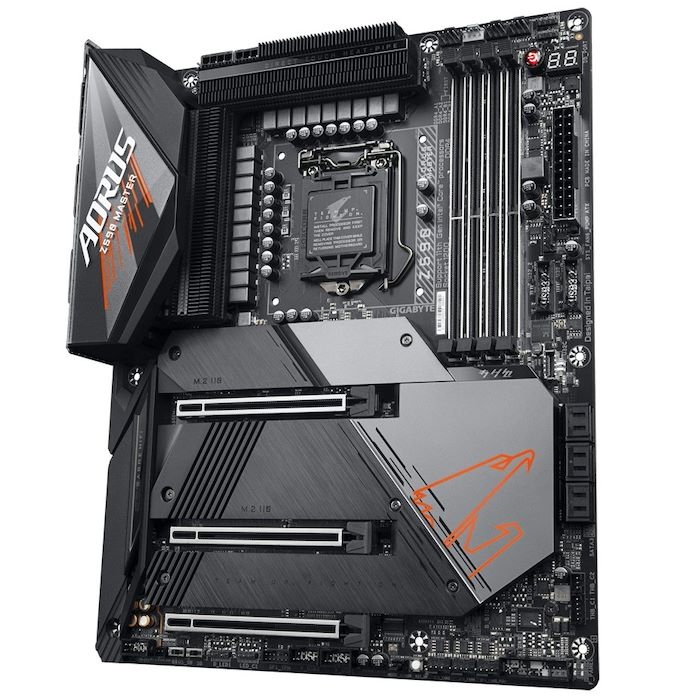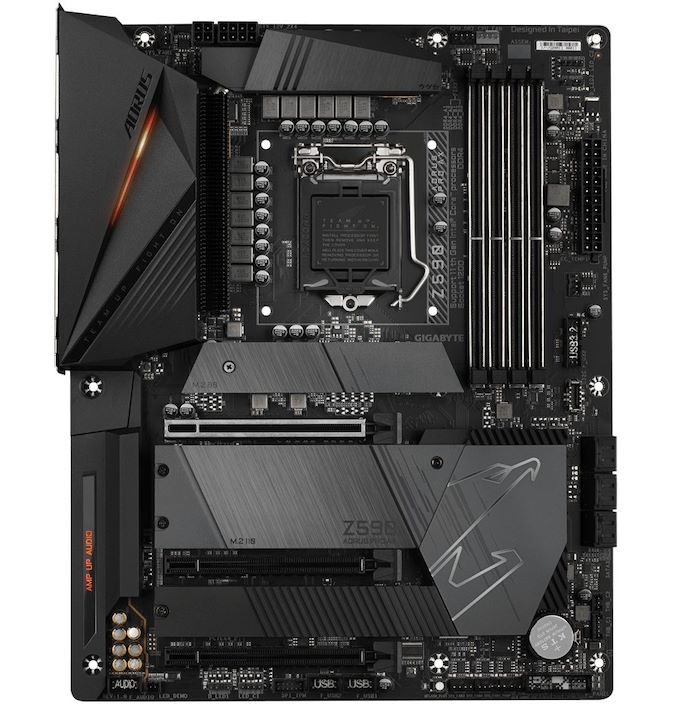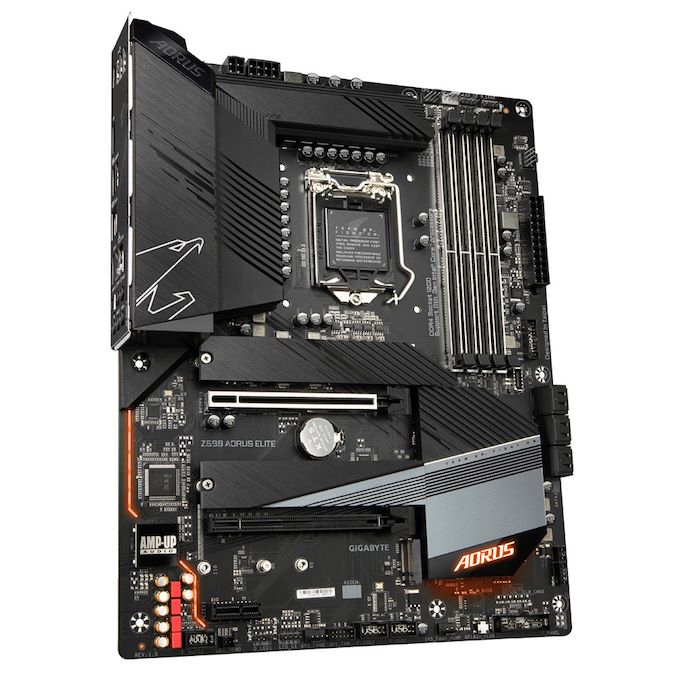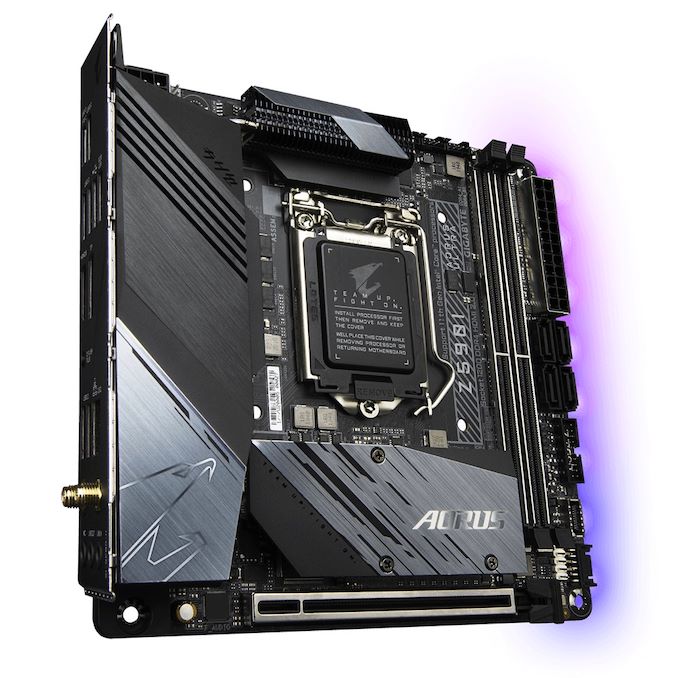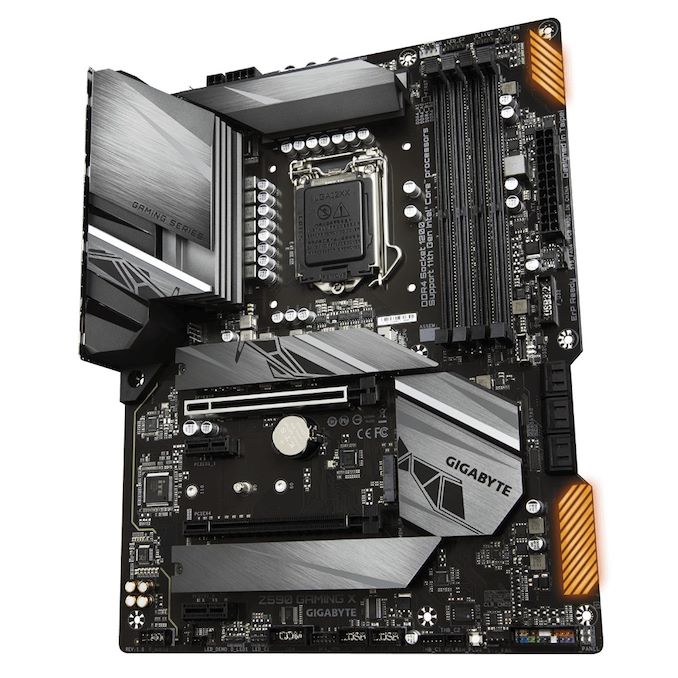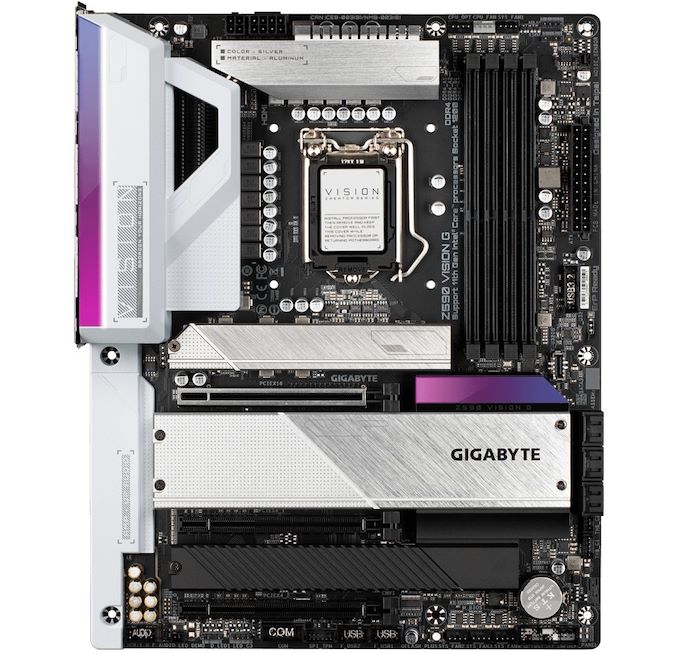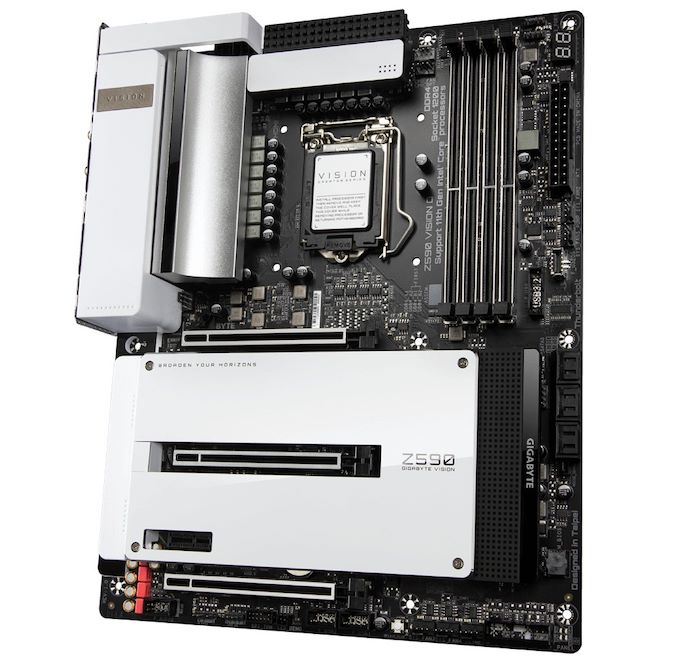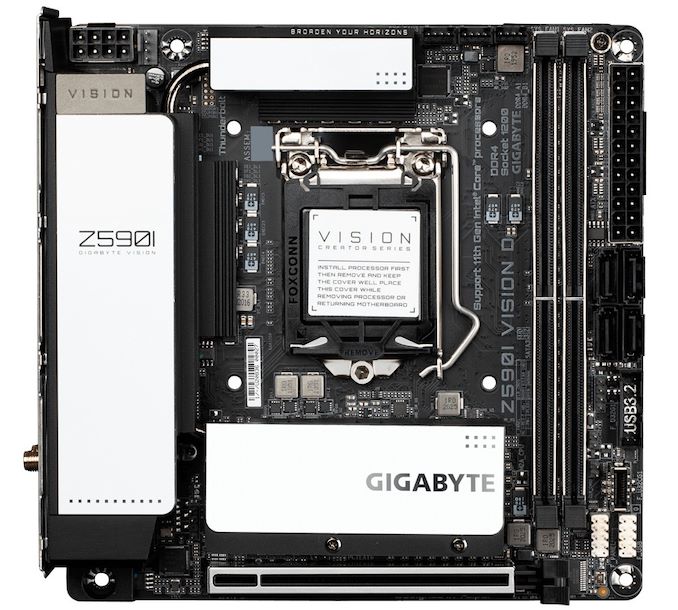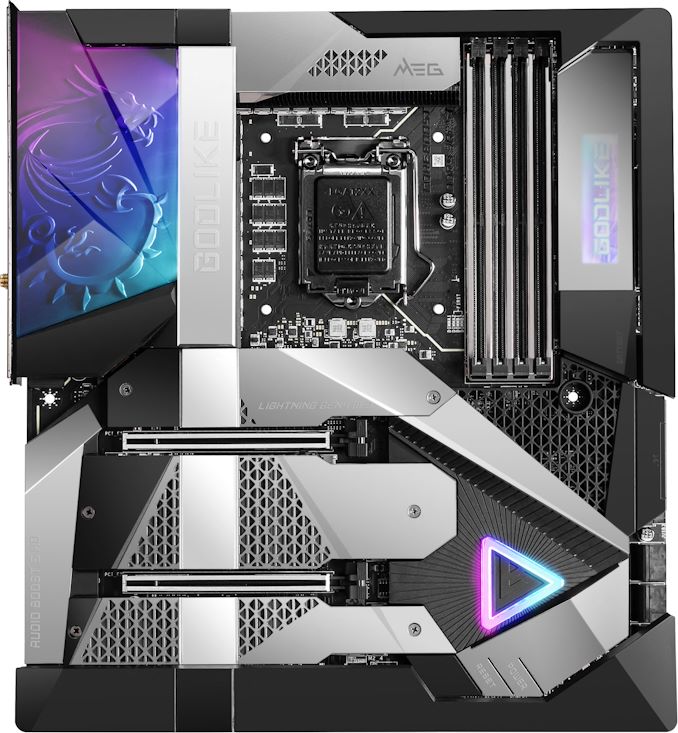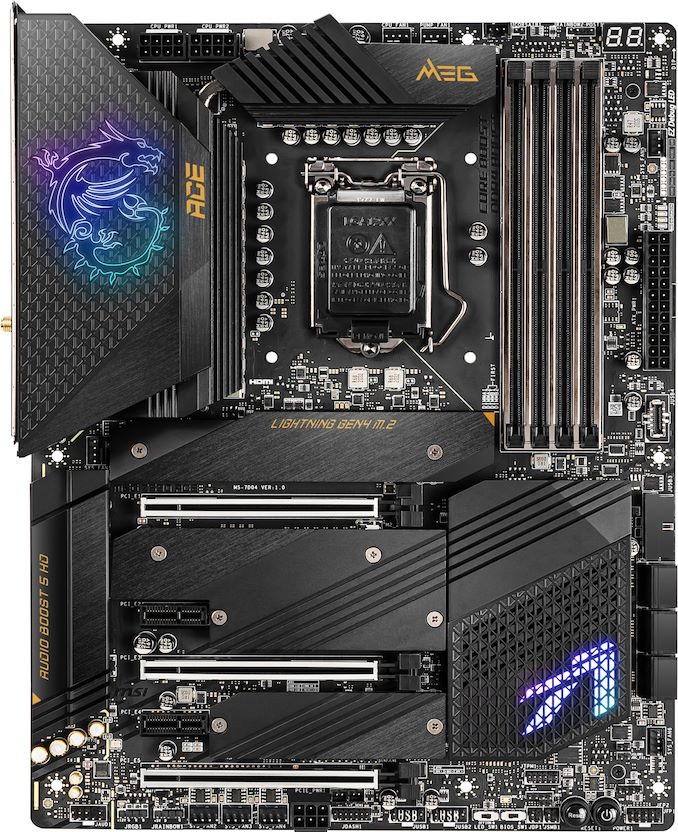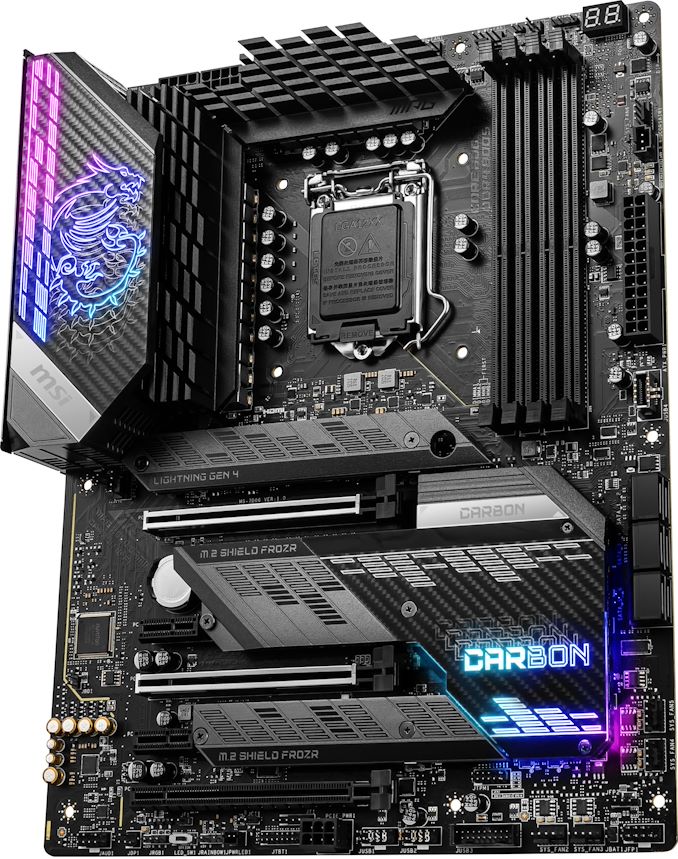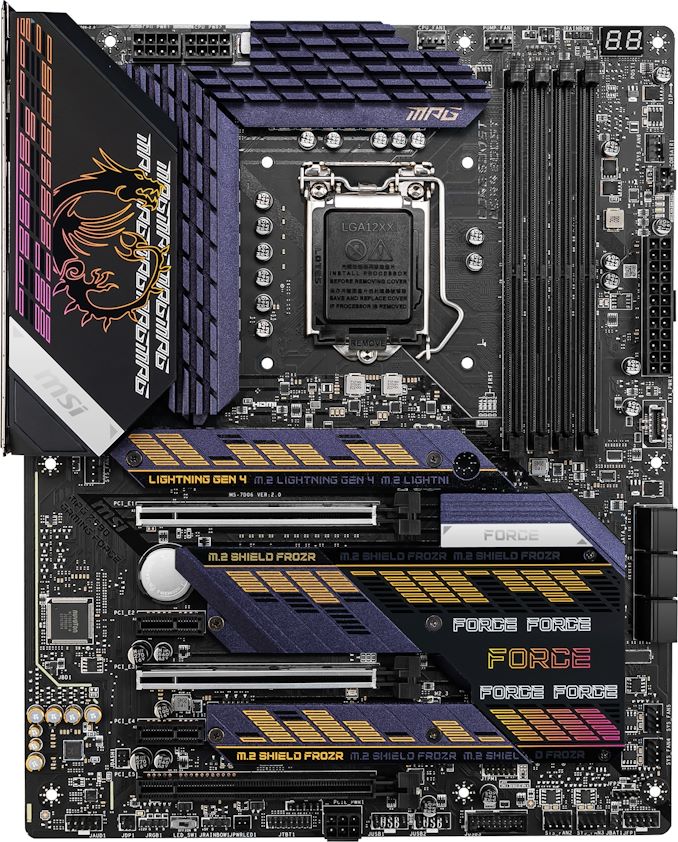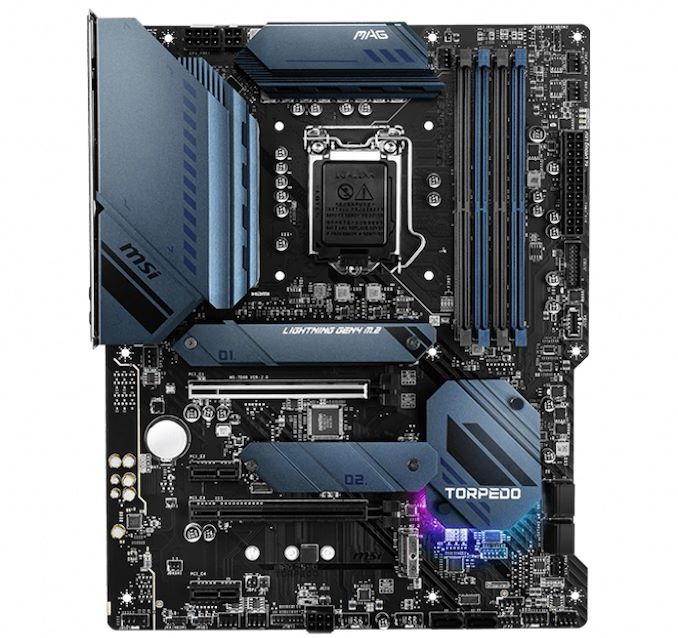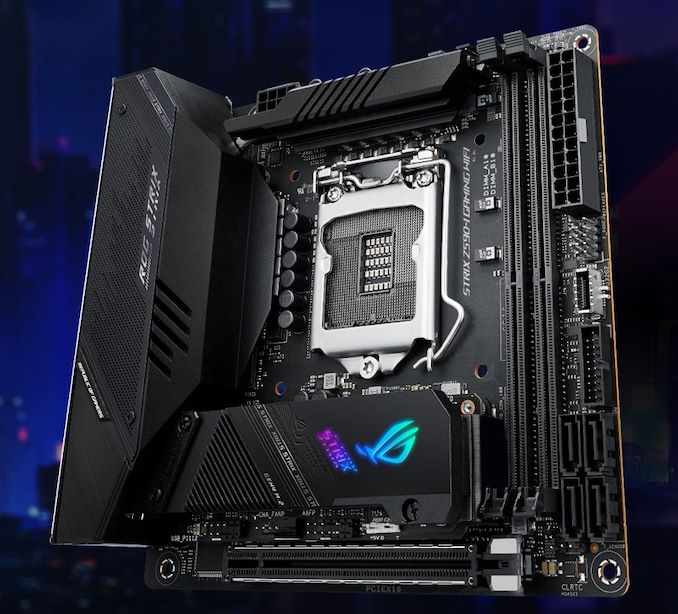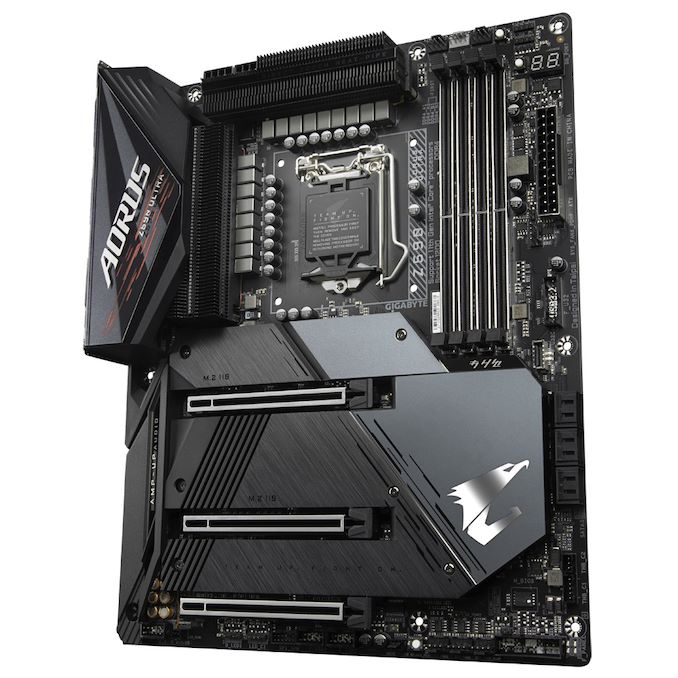
Original Link: https://www.anandtech.com/show/16347/the-intel-z590-overview
The Intel Z590 Motherboard Overview: 50+ Motherboards Detailed
by Gavin Bonshor on January 19, 2021 10:15 AM EST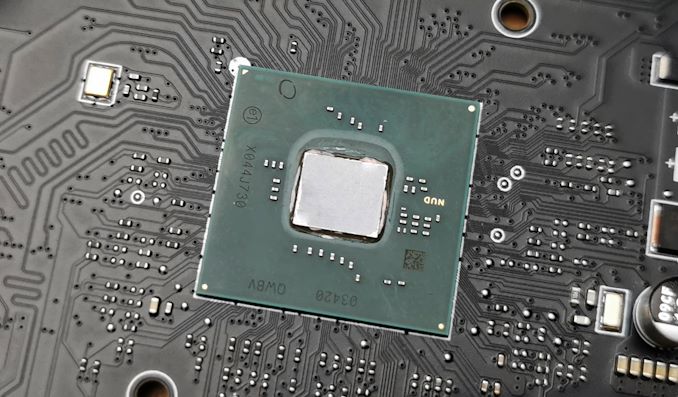
At the start of 2021, Intel has unveiled its latest desktop platform, designed primarily for its Rocket Lake 11th generation processors. Intel is officially moving to PCIe 4.0, with the top SKU Core i9-11900K supposedly offering a large jump in IPC performance compared to the previous generation. The new chipset moves to double bandwidth to the CPU, allowing for more hardware to make the most of the chipset at once. It also moves to DDR4-3200 support, a new peak in a product line that was previously on DDR4-2933. The new Z590 chipset is Intel's flagship, designed for Rocket Lake, but offering backward compatibility with Comet Lake processors. We take a closer look at the large variety of new motherboards set to come to market.
As is usual with a new platform launch, we reached out to every motherboard vendor for their Z590 model list, images, and specifications. Every vendor we spoke to had something on hand, however some products are still under development for launch over the next couple of months. As a result, we have put as much information as we have into this single article to date, and as information is provided, this article will be updated. At the time of publication, we have details of 50+ motherboards. We will endeavor to keep this Z590 overview updated with the latest information, including pricing and new models.
Intel Z590 Chipset: Double Bandwidth to the CPU
Due to the size of the core being used, the newest Rocket Lake flagship is only 8 cores compared to the previous generation's 10, but by contrast, Intel has put a few new features onto the leading flagship chipset, and a number of vendors are straight out of the gate with a wide variety of models and price points. There are two (or three)big differences between the new Z590 and the previous flagship Z490.
First up is the CPU-to-chipset link, which has been doubled from a DMI x4 link to a DMI x8 link. This means an effective CPU-to-chipset bandwidth of a PCIe 3.0 x8 link, and suggests that two PCIe 3.0 x4 drives can be attached and run at full speed.Out of all the 500-series chipsets, we are under the impression that Z590 is the only one that will do this, with all others forcing an x4 link. Also, the x8 link only works with Rocket Lake CPUs, and will downgrade to x4 with a previous generation processor.
The second big difference is that the Z590 platform will enable the processor to use PCIe 4.0. Intel will include native CPU PCIe 4.0 support for the first time, 20 lanes of it, which will enable a full x16 link for add-in cards as well as another PCIe 4.0 x4 for storage. Vendors will be able to split that x16 as required, similar to previous mainstream motherboards, into an x8/x8 or x8/x4/x4 bifurcated solution, with appropriate muxing.
The third update is native USB 3.2 G2x2 (20 Gbps) Type-C support from the chipset. Motherboards that take advantage of this feature will likely enable it either on a front panel or rear panel connector, although it is optional and some of the cheaper models might not have the port.
Intel is also offering better memory support on its 11th Generation processors, which have been upgraded from DDR4-2933 to DDR4-3200. This means that motherboard vendors are building the base specifcation to meet this DDR4-3200 at JEDEC specifications, but most will go beyond this for overclocked memory. Due to the ratio jump, it means that we have motherboards offering up to DDR4-5333, although buying that memory will cost a lot of money. Note that memory profiles higher than DDR4-3200 are classified as overclocking, which officially nullifies any warranty. Intel does in itself offer what it calls PTPP, the Intel Performance Tuning Protection Plan, which is a warranty that can be purchased directly from Intel for an additional cost.
| Intel Z590, Z490, and Z390 Chipset Comparison | |||
| Feature | Z590 | Z490 | Z390 |
| Socket | LGA1200 | LGA1200 | LGA1151 |
| PCIe Lanes (CPU) | 20 | 16 | 16 |
| PCIe Specification (CPU) | 4.0 | 3.0* | 3.0 |
| PCIe Config | x16 x8/x8 x8/x8/x4+4 |
x16 x8/x8 x8/x8/+4 |
x16 x8/x8 x8/x4/+4 |
| DMI Lanes (3.0) | x8 (RKL) | x4 | x4 |
| Chipset PCIe 3.0 Lanes | 24 | 24 | 24 |
| Max USB 3.2 (Gen2/Gen1) | 6/10? | 6/10 | 6/10 |
| USB 3.2 Gen 2x2 (20 Gbps) | Y | ASMedia | N |
| Total USB | 14 | 14 | 14 |
| Max SATA Ports | 6 | 6 | 6 |
| Memory Channels (Dual) | 2/2 | 2/2 | 2/2 |
| Intel Optane Memory Support | Y | Y | Y |
| Intel Rapid Storage Technology (RST) | Y | Y | Y |
| Max Rapid Storage Technology Ports | ? | 3 | 3 |
| Integrated WiFi MAC | Wi-Fi 6 | Wi-Fi 6 | Wi-Fi 5 |
| Intel Smart Sound | Y | Y | Y |
| Integrated SDXC (SDA 3.0) Support | ? | ? | Y |
| Overclocking Support | Y | Y | Y |
| Intel vPro | N | N | N |
| Max HSIO Lanes | ? | 30 | 30 |
| ME Firmware | 15 | 14 | 12 |
| TDP (W) | 6 | 6 | 6 |
The new Intel Z590 chipset now includes native support for USB 3.2 Gen 2x2 20 Gbps Type-C connectivity. On the previous Z490 chipset, vendors needed to use additional controllers, such as the ASMedia ASM3242, plugged into the PCIe lanes from the chipset.
Networking is also a focal point for vendors, with Intel continuing to build in a native Wi-Fi 6 MAC into the chipset, accessible through Intel's proprietary CNVi interface. Vendors will enable this through Intel's latest AX201 or AX210 Wi-Fi 6 RF modules, or the new Intel Killer AX1675 (because if you hadn't heard, Intel purchased the company behind the Killer networking chips).
For wired connectivity, Intel identifies support for 2.5 gigabit Ethernet as a key feature for the new chipsets, however this isn't anything special, as it works the same as in previous generations - motherboard vendors just buy a 2.5 GbE PCIe chip and attach it to the chipset. Though usually when Intel advertises it like this, then there's a combo sale for vendors who buy the chipset along with the Intel branded network controller, so we're going to see a push for 2.5 GbE networking on Z590.
Intel Thunderbolt 4: Support for Maple Ridge
Another new feature found on Z590 models is Intel's Maple Ridge Thunderbolt 4 connectivity. Despite there being little difference between Thunderbolt 4 and the previous Thunderbolt 3, as both allow for 40 GBs of bandwidth and both can drive additional displays, TB4 does offer the full specification standard. Thunderbolt 4 comes with additional security through Intel VT-d DMA protection, can support longer cables with lengths of up to 2 meters, and also tree/branch daisy chaining, whereas previously only linear chaining was supported.
Another benefit for users looking to attach extra screens is Thunderbolt 4 can support up to two 4K and one 8K display, which is a marked improvement over Thunderbolt 3. Systems that want to enable TB4 will do it though the vendor integrating the Maple Ridge chip on the board, as with any other external (external to the chipset) controller.
The Current Z590 Product Stack:
Motherboards Confirmed So Far (as of 01/19)
Through our contact with vendors, we anticipate a total of 55+ models for Z590. Most of these are currently announced and detailed, with a small number announced but waiting for a full detail. Simply put, there will be no shortage of models to select from. Although users might start to baulk at the pricing, with only a small number of boards dipping below the $200 mark.
Surprisingly there isn't much in the way of micro-ATX for Z590, with availability looking limited. We have some mATX from Chinese vendor Colorful, one from ASRock, ASUS and MSI, but little else. For small form factor enthusiasts, ASRock, GIGABYTE, and MSI include a small selection of mini-ITX boards. The vast majority of the Z590 product stack is ATX, although the flagship models from each brand feature E-ATX PCBs with a large selection of PCIe, storage, and premium controller options.
ASRock
ASRock's product stack includes the return of its Phantom Gaming series, which focuses on gaming elements, with the Taichi sitting at the top as the brand's flagship Z590 model. The entry-level Pro 4 series offers an ATX and micro-ATX version, while ASRock's only mini-ITX board to be announced at this time comes via the Z590M-ITX/ac.
| ASRock Z590 Motherboard Product Stack | ||||
| Model | Size | Overview Link |
Review Link |
Price |
| ASRock Z590 Taichi | ATX | Link | TBC | |
| ASRock Z590 PG Velocita | ATX | Link | TBC | |
| ASRock Z590 Extreme WiFi 6E | ATX | Link | TBC | |
| ASRock Z590 Extreme | ATX | Link | TBC | |
| ASRock Z590 Steel Legend 6E | ATX | Link | $212 | |
| ASRock Z590 Steel Legend | ATX | Link | $195 | |
| ASRock Z590 Phantom Gaming 4 AC | ATX | Link | TBC | |
| ASRock Z590 Phantom Gaming 4 | ATX | Link | TBC | |
| ASRock Z590 Pro 4 | ATX | Link | TBC | |
| ASRock Z590M Pro 4 | mATX | Link | TBC | |
| ASRock Z590M-ITX/ac | ITX | Link | TBC | |
ASRock will likely announce even more models for Z590, as the custom monoblock Z590 Aqua is a potential model that could be announced at a later date. We also expect a Phantom Gaming mini-ITX model at some point, which typically offers plenty of premium features.
ASUS
As is typical with ASUS, it has a large Z590 stack, and we have information available for most of its Z590 models; some information is still yet to be announced, however. Some of the models yet to be fully unveiled include the overclocking focused Maximus XIII Apex (Q1), and the Maximus XIII Extreme Glacial with a custom EK monoblock and the standard Extreme variant (also Q1). The usual suspects make its way onto Z590, including the ROG Maximums XIII series, now in its 13th iteration, as well as the mid-range ROG Strix, the budget-focused TUF Gaming, and Prime series.
| ASUS Z590 Motherboard Product Stack | ||||
| Model | Size | Overview Link |
Review Link |
Price |
| ASUS ROG Maximus XIII Extreme Glacial | E-ATX | Link | TBC | |
| ASUS ROG Maximus XIII Extreme | E-ATX | Link | TBC | |
| ASUS ROG Maximus XIII Hero | ATX | Link | $500 | |
| ASUS ROG Maximus XIII Apex | ? | TBC | ||
| ASUS ROG Strix Z590-E Gaming WIFI | ATX | Link | $380 | |
| ASUS ROG Strix Z590-F Gaming WiFi | ATX | Link | TBC | |
| ASUS ROG Strix Z590-A Gaming WiFi | ATX | Link | $330 | |
| ASUS ROG Strix Z590-I Gaming WiFi | ITX | Link | $370 | |
| ASUS TUF Gaming Z590-Plus WIFI | ATX | Link | $260 | |
| ASUS TUF Gaming Z590-Plus | ATX | Link | $240 | |
| ASUS Prime Z590-A | ATX | Link | $280 | |
| ASUS Prime Z590-P | ATX | Link | $189 | |
| ASUS Prime Z590M-Plus | mATX | Link | $175 | |
From the pricing information we have on hand, ASUS's cheapest model will be the ASUS Prime Z590M-Plus, micro-ATX. The entry-level Prime series focuses on basic yet subtle aesthetics, with prices starting upwards of $244. ASUS will also be launching a Strix series mini-ITX model, the ASUS ROG Strix Z590-I Gaming WiFi, but there isn't much in the way of information. We will keep things updated, though, as more details are made available.
Biostar
Biostar has announced a trifecta of models for Z590, with its top model, the Z590 Valkyrie sitting as one of the most premium desktop models we have seen from them in a long time. The latest Valkyrie series uses the native USB 3.2 Gen 2x2 Type-C support, 2.5 gigabit Ethernet, and has a fresh and funky design. Biostar's Racing series is also back for Z590 through the Z590GTA model, with an ATX PCB and a solid entry-level feature set.
| Biostar Z590 Motherboard Product Stack | ||||
| Model | Size | Overview Link |
Review Link |
Price |
| Biostar Z590 Valkyrie | ATX | Link | TBC | |
| Biostar Z590I Valkyrie | ITX | Link | TBC | |
| Biostar Racing Z590GTA | ATX | Link | TBC | |
Biostar is usually a sure thing for at least one mini-ITX model per chipset, and the Z590I Valkyrie is the smaller sibling of the ATX model. It seems like Biostar has gone all out on its Valkyrie models to use the Z590 chipset to its fullest, especially with support for up to DDR5-5000 and 2.5 GbE with premium HD audio codecs.
GIGABYTE:
GIGABYTE has the largest stack with 15 new models unveiled at present. Starting from the top with the GIGABYTE Z590 Aorus Xtreme WaterForce, it caters to the enthusiast market, with top tier level features and a custom monoblock for custom liquid cooling. The Aorus Z590 Xtreme has the same PCB, without the monoblock, and the Aorus range extends from the top end down to the mid-range.
| GIGABYTE Z590 Motherboard Product Stack | ||||
| Model | Size | Overview Link |
Review Link |
Price |
| GIGABYTE Z590 Aorus Xtreme WaterForce | E-ATX | Link | TBC | |
| GIGABYTE Z590 Aorus Xtreme | E-ATX | Link | TBC | |
| GIGABYTE Z590 Aorus Master | ATX | Link | TBC | |
| GIGABYTE Z590 Aorus Tachyon | ATX | TBC | ||
| GIGABYTE Z590 Aorus Pro AX | ATX | Link | TBC | |
| GIGABYTE Z590 Aorus Ultra | ATX | Link | TBC | |
| GIGABYTE Z590I Aorus Ultra | ITX | Link | TBC | |
| GIGABYTE Z590 Aorus Elite AX | ATX | Link | TBC | |
| GIGABYTE Z590 Aorus Elite | ATX | Link | TBC | |
| GIGABYTE Z590 Gaming X | ATX | Link | TBC | |
| GIGABYTE Z590 Vision D | ATX | Link | TBC | |
| GIGABYTE Z590I Vision D | ITX | Link | TBC | |
| GIGABYTE Z590 Vision G | ATX | Link | TBC | |
| GIGABYTE Z590 UD AC | ATX | Link | TBC | |
| GIGABYTE Z590 UD | ATX | Link | TBC | |
Offering a more modest feature set with more cost-effective controllers, the Z590 Gaming X sits just below the Aorus series. In contrast, the Vision series returns with a refreshed Vision D (Designare) and a new Z590 Vision G model with slightly fewer features. GIGABYTE has two mini ITX models, the Z590I Aorus Ultra and the content creator focused Z590I Vision D. For users looking for a more affordable and lower entry point, GIGABYTE has two Ultra Durable series models, the Z590 UD and Z590 UD AC, with the only difference being the latter includes a Wi-Fi module.
MSI
MSI has also gone all out with its Z590 range, with at least 13 new models and more potentially on its way, including an EK monoblock Carbon X version. The MEG, MPG, MAG, and Pro series all return for Z590, with the MEG Godlike sitting as the current flagship with a premium feature set throughout. The Unify range makes a return with an ATX and mini-ITX pairing. The MPG series, which is aimed at gamers with performance in mind, dominates the brand's mid-range, with pricing starting at $264 up to $324. The cheapest starts at $189
| MSI Z590 Motherboard Product Stack | ||||
| Model | Size | Overview Link |
Review Link |
Price |
| MSI MEG Z590 Godlike | E-ATX | Link | $1019 | |
| MSI MEG Z590 Ace | ATX | Link | $489 | |
| MSI MEG Z590 Ace Gold Edition | ATX | Link | - | |
| MSI MEG Z590 Unify | ATX | $389 | ||
| MSI MEG Z590 Unify-X | ? | - | ||
| MSI MEG Z590I Unify | ITX | Link | $329 | |
| MSI MPG Z590 Gaming Carbon WiFi | ATX | Link | $324 | |
| MSI MPG Z590 Gaming Force | ATX | Link | $314 | |
| MSI MPG Z590 Gaming Edge WiFi | ATX | $284 | ||
| MSI MPG Z590M Gaming Edge WiFi | mATX | - | ||
| MSI MPG Z590 Gaming Plus | ATX | $264 | ||
| MSI MAG Z590 Tomahawk WiFi | ATX | Link | $239 | |
| MSI MAG Z590 Torpedo | ATX | Link | $229 | |
| MSI Z590 Pro WiFi | ATX | Link | $209 | |
| MSI Z590 A Pro | ATX | Link | $189 | |
| MSI Z590 Pro 12VO | ATX | TBC | ||
Geared more at the entry-level, the MAG series fires out a Torpedo, and while it might not dent the flagships solely on features, it certainly makes a splash. This is in addition to the Tomahawk which is commonly associated as one of the best models based on price to performance on the market. Lastly, MSI has its Pro series, which targets professionals, and MSI announces a 12VO variant without the need for the 5 V and 3.3 V rails.
Other Z590 Product Stack Options
There are quite a few models outside of the major players.
EVGA is planning on announcing its E-ATX sized overclocking focused EVGA Z590 Dark model sometime later in the year. Primarily designed for overclocking, the EVGA Z590 Dark includes just two memory modules, which are designed to reduce trace latencies for breaking memory world records under liquid nitrogen, with a transposed socket for better LN2 pot mounting. The EVGA Z590 FTW veers off to the more conventional styled motherboard with features aimed at gamers and enthusiasts alike.
Colorful predominantly aims its models at the Asian market with its iGame series and its take on the American Naval fleet with the CVN series.
Supermicro also has two models, one with Wi-Fi and one without, although neither of these includes a PLX chip, which has been a feature in previous generations. This could be an option further down the line.
| Other Z590 Motherboards | ||||
| Model | Size | Overview Link |
Review Link |
Price |
| Colorful iGame Z590 Vulcan X | ATX | Link | TBC | |
| Colorful iGame Z590 Vulcan W | ATX | Link | TBC | |
| Colorful CVN Z590 Gaming Pro V20 | ATX | TBC | ||
| Colorful CVN Z590 Frozen V20 | ATX | TBC | ||
| Colorful CVN Z590M Gaming Pro V20 | mATX | TBC | ||
| Colorful CVN Z590M Frozen V20 | mATX | TBC | ||
| EVGA Z590 Dark | E-ATX | Link | TBC | |
| EVGA Z590 FTW | ATX | Link | TBC | |
| Supermicro C9Z590-CGW | ATX | Link | TBC | |
| Supermicro C9Z590-CG | ATX | Link | TBC | |
On the next page is a summary of each Z590 model power delivery from information which we received from manufacturers or through analysis of the physical board. Each subsequent page is a brief analysis and rundown of each model announced, culminating with a conclusion of board features versus other models.
Z590 Power Delivery
As we do with all of our chipset overviews, we reached out to all of the motherboard vendors about what power deliveries each board features prior to launch. Many more users, compared to previous years factor in the power delivery and its thermal capabilities into their buying decisions. While the power delivery is fundamentally designed to run its relevant processors at default settings without issue, the idea of including a better specification power delivery allows for users to push processors beyond the default settings, as more voltage through the CPU means more voltage and power is handled by the power delivery.
Over the years, we have reported on manufacturers embellishing claims of its power delivery and marketing them to do things it just cannot operate effectively and efficiently. We have compiled as much information as we are privy to, which we are trusting vendors to provide accurate details of. A question mark (?) denotes something we haven't been informed of, as we don't want to speculate and guess, as motherboard vendors haven't provided us with the necessary details.
As more information filters into us from vendors, as well as in our Z590 reviews, we will endeavor to keep the below table updated as frequently as possible. Note that all the information below has come directly from the manufacturer of each model, or through the physical analysis of the componentry.
| Z590 CPU Power Delivery Comparison | |||||
| Motherboard | Controller | H-Side | L-Side | Chokes | Doubler |
| Biostar Z590 Valkyrie | ISL69269 (10+1) |
ISL99390B (20) |
? | ISL6617A (10) |
|
| Biostar Z590I Valkyrie | ISL69269 (8+1) |
ISL99390 (8) |
? | - | |
| Biostar Racing Z590GTA | ISL69269 (6+1) |
FDMF5062 (12) |
? | ISL6617A (6) |
|
| GIGABYTE Z590 Aorus Xtreme WaterForce | ISL69269 (10+1) |
SiC840 (20) |
? | ISL6617A (10) |
|
| GIGABYTE Z590 Aorus Xtreme | ISL69269 (10+1) |
SiC840 (20) |
? | ISL6617A (10) |
|
| GIGABYTE Z590 Aorus Tachyon | ISL69269 (12+1) |
SiC840 (12) |
? | - | |
| GIGABYTE Z590 Aorus Master | ISL69269 (18+1) |
ISL99390B (18) |
? | ISL6617A (9) |
|
| GIGABYTE Z590 Aorus Ultra | ISL69269 (8+1) |
ISL99390B (16) |
? | ISL6617A (8) |
|
| GIGABYTE Z590 Aorus Pro AX | ISL69269 (12+1) |
ISL99390 (12) |
? | - | |
| GIGABYTE Z590 Aorus Elite | ISL69269 (12+1) |
SiC649 (12) |
? | - | |
| GIGABYTE Z590I Aorus Ultra | ISL69269 (10+1) |
ISL99390 (10) |
? | - | |
| MSI MEG Z590 Godlike | RAA229828 (20+0) |
ISL99390 (20) |
? | - | |
| MSI MEG Z590 Ace | ISL69269 (16+2) |
ISL99390B (16) |
? | ISL6617A (8) |
|
| MSI MEG Z590 Unify | ISL69269 (16+2) |
ISL99390B (16) |
? | ISL6617A (8) |
|
| MSI MEG Z590 Unify-X | ISL69269 (16+2) |
ISL99390B (16) |
? | ISL6617A (8) |
|
| MSI MEG Z590I Unify | ISL69269 (8+1) |
ISL99390 (8) |
? | - | |
| MSI MPG Z590 Gaming Carbon WIFI | ISL69269 (16+1) |
RAA220075 (16) |
? | - | |
| MSI MPG Z590 Gaming Carbon EK X | ISL69269 (16+1) |
RAA220075 (16) |
? | - | |
| MSI MPG Z590 Gaming Force | ISL69269 (16+1) |
RAA220075 (16) |
? | - | |
| MSI MPG Z590 Gaming Edge WIFI | ISL69269 (14+1) |
RAA220075 (14) |
? | - | |
| MSI MPG Z590M Gaming Edge WIFI | ISL69269 (12+1) |
RAA220075 (12) |
? | - | |
| MSI MPG Z590 Gaming Plus | ISL69269 (14+1) |
RAA220075 (14) |
? | - | |
| MSI MAG Z590 Tomahawk WIFI | ISL69269 (14+2) |
AOZ5312UQI (14) |
? | - | |
| MSI MAG Z590 Torpedo | ISL69269 (14+2) |
NCP252160 (14) |
? | - | |
| MSI Z590 Pro WIFI | RT3609BE (12+2) |
AOZ5516QI (12) |
? | - | |
| MSI Z590-A Pro | RT3609BE (12+2) |
AOZ5516QI (12) |
? | - | |
As we get more and more Z590 boards in for review, we can go deeper into the analysis in each individual review over the upcoming months.
We start with ASRock's models by opening up our overview of each Z590 motherboard in alphabetical order (by the vendor). ASRock uses the latest Intel Killer Wi-Fi 6E CNVi across its models. There is also an an ASRock Graphics Card Holder, designed to support bulky cards.
ASRock Z590 Taichi
Many years ago, ASRock entered into a sponsorship deal with a successful gamer to produce its gaming models. What they got was mostly a name to sell the hardware, and since then ASRock's most notable motherboard line is now the Taichi. Originally unveiled for Intel's Z270 chipset, it's a regular mainstay with its solid blend of cogwheel inspired aesthetics and premium features. The ASRock Z590 Taichi is ATX and looks to be the brand's flagship model at present.
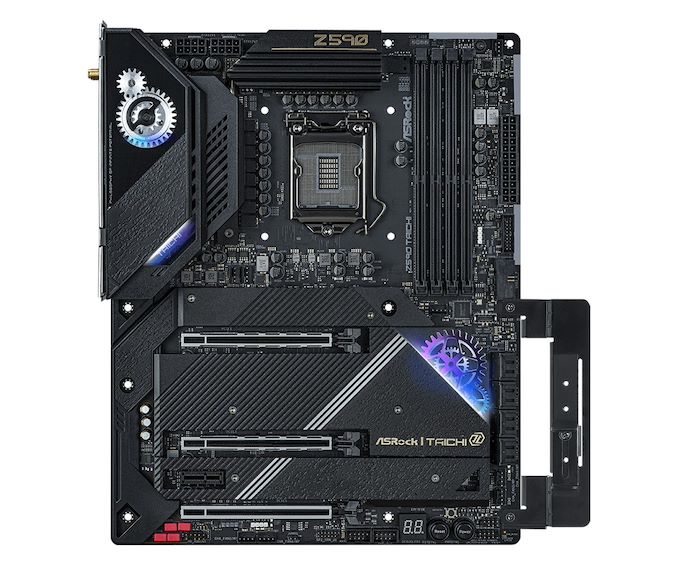
ASRock Z590 Taichi with ASRock's new GPU holder
For 2021, the ASRock Z590 Taichi has opted for a more clean-cut all-black aesthetic, with RGB LED lighting elements within the rear panel, the chipset heatsink, and the underside of the board at the right-hand side. ASRock is also advertising an 8-layer PCB with a 14-phase power delivery with 90 A power stages. The Z590 Taichi includes three full-length slots, with the top slot operating at PCIe 4.0 x16, two of them running at x8/x8, and a single small PCIe 3.0 x1 slot. Other features include triple M.2 slots, with one operating at PCIe 4.0 x4 from the CPU and two with PCIe 3.0 x4 from the chipset. These final two have SATA support, as well as the eight traditional SATA ports. It also includes four memory slots with support for DDR4-5000 memory, with a maximum capacity of 128 GB.
The rear panel includes dual Thunderbolt/USB 4.0 Type-C ports, with two USB 3.2 G2 Type-A and four USB 3.2 G1 Type-A ports. It includes dual Ethernet, one driven by a Killer E3100G 2.5 G NIC and the other by an undisclosed Intel Gigabit controller. Wireless connectivity comes from an undisclosed Wi-Fi 6E interface, likely the Intel AX210, which includes support for BT 5.2. It uses a Realtek ALC1220 HD audio codec for onboard audio, with an assisting ESS Sabre ES9128 DAC for uprated audio capability. There is also a single HDMI video output.
At the time of writing, ASRock hasn't shared details on its Z590 pricing.
ASRock Z590 PG Velocita
Moving down from the Z590 Taichi is the ASRock Z590 PG Velocita. The PG stands for Phantom Gaming, ASRock's gaming-focused range, with aggressive yet stylish aesthetics. We reviewed the previous ASRock Z490 PG Velocita last year, and for 2021, ASRock has updated the design for Z590. This includes a futuristic RGB enabled chipset heatsink, with other RGB included in the rear panel cover.
The ASRock Z590 PG Velocita includes three full-length PCIe slots with ASRock Steel Armor, with the top two slots operating at PCIe 4.0 x16, and x8/x8, the third operating at PCIe 3.0 x4, with a single PCIe 3.0 x1 slot. There are four memory slots with support for DDR4-4800, with a maximum combined total of 128 GB. For storage, ASRock includes one PCIe 4.0 x4 M.2 slot, with two PCIe 3.0 x4 M.2/SATA slots, with six SATA ports. Located in the top-right hand corner is an onboard power and reset button pairing, while a two-digit LED debugger can be found at the bottom right.
On the rear panel is one USB 3.2 G2 Type-C, one USB 3.2 G2 Type-A, and six USB 3.2 G1 Type-A ports, with a DisplayPort 1.4 and HDMI video output pairing for users looking to use Intel's integrated graphics. Networking is provided by two Ethernet controllers, including a Killer E3100 2.5 GbE and Intel Gigabit pairing. Wireless is provided by a new Killer AX1675 Wi-Fi 6E CNVi with support for BT 5.2 devices. The onboard audio is powered by a Realtek ALC1220 HD audio codec and uses Nahamic audio control.
At the time of writing, ASRock hasn't shared details on its Z590 pricing.
ASRock Z590 Phantom Gaming 4 and 4/AC
The ASRock Z590 Phantom Gaming 4 AC and the non-WiFi version, the Z590 Phantom Gaming 4, represent its entry-level. It follows a fundamental layout, with much smaller heatsinks than the more high-end Z590 PG Velocita. It includes a pair of silver power delivery heatsinks, which cool the advertised 8-phase VRM, and a small silver chipset heatsink.
The ASRock Z590 Phantom Gaming 4/AC and Z590 Phantom Gaming share identical features, minus the Wi-Fi on the non AC version. Located towards the board's center are two full-length PCIe slots, with the top slot operating at PCIe 4.0 x16 and the second slot locked at PCIe 3.0 x4. It also includes three PCIe 3.0 x1 slots, with three M.2 slots. The M.2 slots include a PCIe 4.0 x4 slot at the top and two PCIe 3.0 x4/SATA M.2 slots, with six SATA ports supporting RAID 0, 1, 5, and 10 arrays. The top right-hand corner is four memory slots with support for DDR4-4800 and can accommodate up to 128 GB.
The rear panel is basic, with the Z590 Phantom Gaming 4/AC including an Intel Wi-Fi 5 CNVi. Both models share the rest, including one USB 3.2 G2 Type-C, one USB 3.2 G2 Type-A, two USB 3.2 G1 Type-A, and two USB 2.0 ports. Powering the single RJ45 port is an unspecified Gigabit Ethernet controller, while an older Realtek ALC897 HD audio codec drives the three 3.5 mm audio jacks. Finishing off the rear panel is one HDMI video output, with a PS/2 keyboard and mouse combo port for legacy peripherals.
At the time of writing, ASRock hasn't shared details on its Z590 pricing.
ASRock Z590 Extreme & Extreme WiFi 6E
The ASRock Z590 Extreme WiFi 6E benefits from an Intel Killer Wi-Fi 6E CNVi and looks a more clean-cut offering design-wise than the Phantom Gaming series. It uses an ATX PCB with an X-shaped cutout to provide better access to some of the SATA ports for improved cable management. It follows a black design throughout, with blue accents on the rear panel cover and chipset heatsinks, with some lighting in the rear panel. There is also a version without Intel's Wi-Fi 6E variant, which will be slightly cheaper.
Dominating the lower portion of the board are two full-length PCIe slots, including one PCIe 4.0 x16 slot with ASRock's Steel Slot Armor reinforcement, while the second operates at PCIe 3.0 x4. There is also three PCIe 3.0 x1 slots. The board includes three M.2 slots, with the top one supporting PCIe 4.0 x4 and the other two supporting PCIe 3.0 x4/SATA drives. A cut-out provides better access to four SATA ports, with two straight-angled ports for a combined total of six, including support for RAID 0, 1, 5, and 10 arrays. ASRock is also advertising the Z590 Extreme WiFi 6E to include a 14-phase power delivery.
In terms of connectivity, the ASRock Z590 Extreme WiFi 6E includes one USB 3.2 G2 Type-C, one USB 3.2 G2 Type-A, two USB 3.2 G1 Type-A, and two USB 2.0 ports. It uses dual RJ45 ports with a Realtek RTL8125 2.5 GbE and undisclosed Intel Gigabit controller pairing. It uses an undisclosed Wi-Fi 6E interface for wireless connectivity with support for BT 5.2 devices on the Wi-Fi enabled version, while the regular Z590 Extreme omits this. The onboard audio includes five 3.5 mm jacks and S/PDIF optical output powered by a Realtek ALC1220 HD audio codec. Finishing off the rear panel is a pair of video outputs, including a DisplayPort and HDMI, with a PS/2 combo keyboard and mouse port.
At the time of writing, ASRock hasn't shared details on its Z590 pricing.
ASRock Z590 Steel Legend & SL Wi-Fi 6E
One of ASRock's more recent ranges comes via the Steel Legend series, represented by the ASRock Z590 Steel Legend Wi-Fi 6E. It marks a much different design from its other Z590 models with an urban camouflaged PCB and silver and white accented heatsinks. It includes an illuminated Steel Legend logo in the rear panel cover and chipset heatsink, with more RGB LEDs, integrated on the right-hand side. ASRock also has a non-Wi-Fi 6E variant, the same board, but without the CNVi.
The ASRock Z590 Steel Legend WiFi 6E includes two full-length PCIe slots, including a PCIe 4.0 x16 slot up top, while the second slot is locked down at PCIe 3.0 x4, with three PCIe 3.0 x1 slots. There are four memory slots with support for DDR4-4800 memory and the capability for users to install up to 128 GB. Storage options include three M.2 slots, one operating at PCIe 4.0 x4, and the other two restricted to PCIe 3.0 x4/SATA. ASRock includes six SATA ports with support for RAID 0, 1, 5, and 10 arrays for more conventional storage. ASRock also advertises a large 14-phase power delivery with DR. MOS power stages.
ASRock includes one USB 3.2 G2 Type-C on the rear panel, one USB 3.2 G2 Type-A, two USB 3.2 G1 Type-A, and two USB 2.0 ports. There's a pair of video outputs, including one HDMI and one DisplayPort, with the board's five 3.5 mm audio jacks and S/PDIF optical output driven by an older Realtek ALC897 HD audio codec. The networking array includes one Realtek RTL8125 2.5 GbE controller, with an undisclosed Wi-Fi 6E CNVi providing both wireless and BT 5.2 connectivity. The ASRock Z590 Steel Legend omits the Wi-Fi 6E, but everything else is the same.
At the time of writing, ASRock hasn't shared details on its Z590 pricing.
ASRock Z590 Pro4
The ASRock Z590 Pro 4 is another entry-level series for users, specifically focusing on basic features and aesthetics. For those that don't care too much for gaming-specific features, the Z590 Pro 4 still has plenty going for it. It uses a black and silver printed PCB, with a pair of silver heatsinks cooling an advertised 14-phase power delivery, and an RGB enabled chipset heatsink.
The feature set is a pair of full-length PCIe slots, with the top slot operating at PCIe 4.0 x16 and the second slot electronically locked to PCIe 3.0 x4, with three additional PCIe 3.0 x1 slots. Memory support includes DDR4-4800, with a maximum capacity of up to 128 GB across four available memory slots. There are three M.2 slots in total for storage, including one PCIe 4.0 x4 M.2 and two PCIe 3.0 x4/SATA M.2 slots, with six SATA ports for more conventional SATA based drives. The SATA slots are split up into two sections, with four right-angled ports and two straight angled ports, with all of them including support for RAID 0, 1, 5, and 10 arrays.
The ASRock Z590 Pro4 omits any Wi-Fi connectivity, but it does include an unspecified 2.5 GbE controller powering one RJ45 port. It also lacks Type-C connectivity, with just two USB 3.2 G2 Type-A, two USB 3.2 G1 Type-A, and two USB 2.0 ports. It includes a pair of video outputs for integrated graphics, including DisplayPort 1.4 and HDMI, with an older Realtek ALC897 HD audio codec powering three 3.5 mm audio jacks. Finishing off the rear panel is a PS/2 keyboard and mouse combo port.
At the time of writing, ASRock hasn't shared details on its Z590 pricing.
ASRock Z590M Pro4
The ASRock Z590M Pro 4 is the micro-ATX version of the ATX Z590 Pro 4, with a very similar feature set and aesthetic. The Z590M Pro 4 includes a silver and black printed PCB, silver heatsinks, and is one of just a tiny handful of micro-ATX models on Z590. ASRock is advertising a 12-phase power delivery, likely to the same spec as the larger Z590 Pro4. The Pro4 does include limited RGB capability, with LEDs integrated around the chipset heatsink.
The ASRock Z590 Pro4 includes two full-length PCIe slots, with the top slot operating at PCIe 4.0 x16 and the second slot at PCIe 3.0 x4, with two PCIe 3.0 x1 slots. The board includes four memory slots with support for DDR4-4800 and a maximum combined total of 128 GB. Storage options include two M.2 slots, including one PCIe 4.0 x4 and one PCIe 3.0 x4/SATA M.2 slot, as well as four SATA ports, two right-angled and two-straight angled with support for RAID 0, 1, 5, and 10 arrays.
On the rear panel are two USB 3.2 G2 Type-A, two USB 3.2 G1 Type-A, and two USB 2.0 ports, with a single Ethernet port powered by an unspecified Gigabit controller. The board includes three 3.5 mm audio jacks powered by a Realtek ALC897 HD audio codec, with a DisplayPort and HDMI video output pairing for users leveraging Intel's HD graphics. Finishing off the rear panel is a PS/2 keyboard and mouse combo port designed for legacy peripherals.
At the time of writing, ASRock hasn't shared details on its Z590 pricing.
ASRock Z590M-ITX/ac
ASRock's only mini-ITX model known at this time is the basic looking yet elegant Z590M-ITX/ac. Small form factor systems are still popular with enthusiasts, and ASRock, over the years, has had some of the best examples of how to get mini-ITX done properly. The ASRock Z590M-ITX/ac includes a black and gray printed PCB with silver heatsinks and is advertising an 8-phase power delivery.
The ASRock Z590M-ITX/ac includes one full-length PCIe 4.0 x16 slot, two M.2 slots, one PCIe 4.0 x4, and one with support for PCIe 3.0 x4 and SATA drives. ASRock includes four SATA ports, all with straight-angled connectors, with all four supporting RAID 0, 1, 5, and 10. Due to the limitations of mini-ITX, there are two memory slots, with support for up to DDR4-5066 and a maximum capacity of up to 64 GB. Located just below the SATA is a single USB 3.2 G2 Type-C header.
On the rear panel is a single USB 3.2 G2x2 Type-C, four USB 3.2 G2 Type-A, and one USB 2.0 port. The three 3.5 mm audio jacks are powered by a Realtek ALC897 HD audio codec, while the board's networking includes dual RJ45 ports, one driven by a Realtek RTL8125 2.5 Gb and the other by an Intel I219-V Gigabit controller. ASRock is also using Intel's latest AX210 Wi-Fi 6E CNVi, including support for BT 5.2 devices. Last but not least are a pair of video outputs, including DisplayPort 1.4 and HDMI 2.0.
At the time of writing, ASRock hasn't shared details on its Z590 pricing.
ASUS has prepared an impressive line up of Z590 models. Starting with the flagships, ASUS has two prepared two new Extreme models, the ROG Maximus XIII Extreme Glacial and ROG Maximus XIII Extreme.
ASUS ROG Maximus XIII Extreme & Extreme Glacial
Both of these share the same core feature set with an advertised large 20-phase power delivery (18+2) with impressive 100 A teamed power stages. Interestingly, the Maximus XIII Extreme Glacial looks to include a centrally located screen, which could be customizable, but ASUS hasn't provided us any details at time of writing.
The biggest difference between both models is that the ROG Maximus XIII Extreme Glacial includes a large monoblock developed between ASUS and EK. This provides coverage of the CPU socket, power delivery, and chipset for liquid-cooled systems. ASUS includes integrated RGB LED lighting across both models, which can be found within the window of the monoblock and chipset area on the Extreme Glacial. On the Extreme, it is integrated into the rear panel cover and chipset heatsink of the Extreme, with both boards benefiting from a strip on the underside of the PCB at the right-hand side.
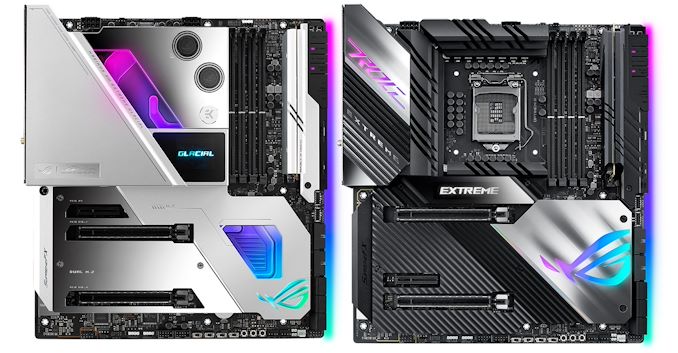
ASUS ROG Maximus XIII Extreme Glacial (left) and Extreme (right) motherboards
Both models include two full-length PCIe 4.0 slots that operate at x16 and x8/x8, with a half-length PCIe 3.0 x4 slot. The PCIe 3.0 x4 slot is located at the top of the PCIe slot area on the Extreme Glacial, while it's the second slot on the non-monoblock version. Storage consists of three M.2 slots with all of them operating at PCIe 4.0 x4, although two of these revert to PCIe 3.0 x4 with Comet Lake processors and the third completely disabled without an 11th Gen Rocket Lake CPU installed. The ROG Maximus XIII Extreme and Glacial version includes six SATA ports with support for RAID 0, 1, 5, and 10 arrays, with four memory slots that can accommodate up to 128 GB of DDR4-5333 memory.
Included with both models is a new ROG Clavis USB Type-C DAC, with four ESS audio converters for variable spectral audio ranges. ASUS states that this ensures the highest levels of SnR with low distortion, with isolation shielding to ensure minimal interference.
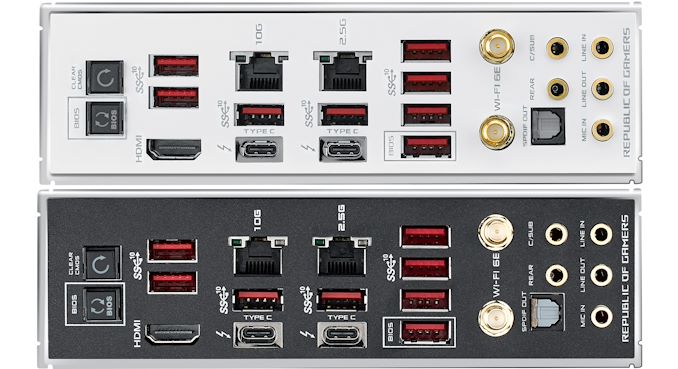
ASUS ROG Maximus XIII Extreme Glacial (top) and Extreme (bottom) rear panels
On the rear panel of both boards, the only difference is in the color of the pre-attached rear I/O shield, white on the Glacial, and black on the regular Extreme model. ASUS has a stacked USB configuration, including two Thunderbolt 4 Type-C and eight USB 3.2 G2 Type-A ports. Networking capabilities include a Marvell AQtion AQC113CS 10 GbE controller, with a second Intel I225-V 2.5 Gb Ethernet port. The board also includes an Intel AX210 Wi-Fi 6E CNVi, with five 3.5 mm audio jacks and S/PDIF optical output powered by a SupremeFX ALC4082 and ESS Sabre ES9018Q2C DAC. To the far left of the panel are a clear CMOS and BIOS Flashback button pairing, with a single HDMI video output.
The ASUS ROG Maximus XIII Extreme Glacial is set to cost a whopping $1843, which I believe is the most expensive desktop motherboard to exist outside of workstation and HEDT variations. Based on this, the target market is likely to be slim, and I don't expect ASUS to shift as many units as its other boards. It's incredibly high-end, but outside of adding an aftermarket CPU block, even at the upper end for $1000 to the ROG Maximus XIII Extreme ($1166), it's an insane price.
ASUS ROG Maximus XIII Hero
Another model from ASUS's ROG Maximus line-up is the highly favorable Hero. The ROG Maximus XIII Hero offers Wi-Fi 6E, with dual 2.5 GbE and four PCIe M.2 slots. It uses a slightly different aesthetic compared with the previous Z490 Hero, with RGB LED lighting built into the rear panel cover and chipset heatsink. Still, ASUS's illustration leaves the question open whether or not the power delivery heatsink has them integrated too, which seems unlikely. The new Hero uses an ATX PCB, with a 14+2 power delivery with 90 A teamed power stages. Powering the CPU is a pair of 12 V ATX CPU power inputs.
The ASUS ROG Maximus XIII Hero includes a nice black and dark gray contrasting design, with three full-length PCIe slots. The top two operate at PCIe 4.0 x16 and x8/x8, while the bottom full-length slot is locked to PCIe 3.0 x4, and there is also one PCIe 3.0 x1 slot. The Hero includes six SATA ports with support for RAID 0, 1, 5, and 10 arrays, with four PCIe M.2 slots. Two of the M.2 slots operate at PCIe 4.0 x4, while the other two can support PCIe 3.0 x4 and SATA drives. In the top right-hand corner are four memory slots with support for up DDR4-5333, with a combined capacity of 128 GB. In the top right-hand corner of the board is a two-digit LED debugger, with a power on and rest switch pairing just below it.
On the rear panel is two Thunderbolt 4 Type-C, with six USB 3.2 G2 Type-A and two USB 2.0 ports. ASUS includes two RJ45 ports powered by two Intel I225-V 2.5 GbE controllers, with an Intel AX210 Wi-Fi 6E CNVi, which also includes support for BT 5.2 devices. For users planning to use Intel's integrated graphics, ASUS includes one HDMI video output. Regarding audio, ASUS is using a SupremeFX ALC404082 HD audio codec, with an ESS Sabre9018Q2C DAC. Finishing off the rear panel is a clear CMOS button and a BIOS Flashback button with a highlighted USB 2.0 port, which users can use to flash the board's firmware.
Typically bridging the gap between the ROG Maximus Extreme and Formula models to the Strix series, ASUS has set a price of $500. While this does seem on the high side of Z590 pricing, which we already know, ASUS does include a stacked rear panel including dual Thunderbolt 4 Type-C, dual 2.5 GbE, Wi-Fi 6E, as well as six USB 3.2 G2 Type-A.
ASUS ROG Maximus XIII Apex
At the time of writing, we have been made aware that the ASUS ROG Maximus XIII Apex will be announced at some stage. However the case, we have no details about it and this page is a placeholder for when those details are shared with us.
ASUS ROG Strix Z590-E Gaming WIFI
The ASUS ROG Strix Z590-E Gaming WIFI represents the mid-range and includes an advertised 14+2 phase power delivery, with four PCIe M.2 slots, dual Intel 2.5 GbE, and Intel's latest Wi-Fi 6E CNVi. It follows an all-black design, with ASUS's holographic logo embossed onto the rear panel cover, the top M.2 heatsink, and in the bottom left-hand corner of the chipset heatsink. ASUS includes its Optimem III memory technology and has four memory slots with support for up to 128 GB of memory.
ASUS includes three full-length PCIe slots, with the top two of these featuring support for PCIe 4.0 x16 and x8/x8, with the bottom slot electronically locked at PCIe 3.0 x4. There are four PCIe M.2 slots for storage, two with support for PCIe 4.0 x4 and two PCIe 3.0 x4/SATA M.2 slots. Six SATA ports are located at the right-hand side, with support for RAID 0, 1, 5, and 10 arrays. Onto the memory and the Z590-E Gaming WIFI has support for up to 128 GB and can run with speeds of up to DDR4-5333. Other notable features include a two-digit LED debugger in the top right-hand corner and a 16-phase (14+2) power delivery, which is powered by an 8-pin and 4-pin 12 V ATX CPU power input pairing.
The rear panel includes one USB 3.2 G2x2 Type-C, one USB 3.2 G2 Type-C, two USB 3.2 G2 Type-A, four USB 3.2 G1 Type-A, and two USB 2.0 ports. ASUS includes a pair of video outputs, including DisplayPort 1.4 and HDMI 2.0, with five 3.5 mm audio jacks and S/PDIF optical output powered by a Realtek ALC4080 HD audio codec and a Savitech SV3H712 amplifier. There's a pair of Intel I225-V 2.5 GbE controllers for networking, with an Intel AX210 Wi-Fi 6E CNVi with support for BT 5.2 devices. ASUS also includes a small clear CMOS switch and a BIOS Flashback button with a designated USB 2.0 port, which is highlighted on the pre-attached rear I/O shield.
Preliminary pricing suggests the ASUS ROG Strix Z590-E Gaming WIFI will retail for around $380, which isn't a bad price considering all the board has to offer. The Strix series typically targets the mid-range, but with ASUS opting to bolsters most of its main ranges with premium controllers, the ROG Strix Z590-E Gaming WIFI sits directly below the ROG Maximus XIII Hero in ASUS's stack.
ASUS ROG Strix Z590-F Gaming WIFI
The ASUS ROG Strix F series is typically one of its most well-positioned models when factoring in both price and performance. It is a competitive alternative to the slightly higher-end Strix Z590-E Gaming WIFI, with plenty of features, including four M.2 slots, 2.5 GbE, and the latest Realtek HD audio codec. Its design follows a primarily black color scheme, with silver accents on the rear panel cover, including an RGB enabled Republic of Gamers logo. ASUS is advertising a 14+2 phase power delivery, with an 8-pin and 4-pin 12 V ATX power input pairing.
Looking at expansion support, ASUS includes three full-length PCIe slots, including two full-length slots operating at PCIe 4.0 x16 and x8/x8, while the third full-length slot is electronically locked to PCIe 3.0 x4. For storage, ASUS includes four PCIe M.2 slots, including two operating at PCIe 4.0 x4, with one supporting PCIe 3.0 x4 and another at PCIe 3.0 x4/SATA. There are six SATA ports, with support for RAID 0, 1, 5, and 10 arrays. The ASUS ROG Strix Z590-F Gaming Wi-Fi also has four memory slots, with supported speeds of up to DDR4-5333 and a maximum capacity of up to 128 GB.
On the rear panel is one USB 3.2 G2x2 Type-C, one USB 3.2 G2 Type-A, two USB 3.2 G2 Type-A, four USB 3.2 G1 Type-A, and two USB 2.0 ports. ASUS uses an Intel I225-V 2.5 GbE controller with an Intel AX210 Wi-Fi 6E CNVi and includes five 3.5 mm audio jacks and S/PDIF optical output driven by a Realtek ALC4080 HD audio codec and Savitech SV3H712 amplifier. Finishing off the rear panel is a DisplayPort and HDMI video output pairing, a clear CMOS switch, and a BIOS Flashback button.
ASUS ROG Strix Z590-A Gaming WIFI
The ASUS ROG Strix Z590-A Gaming WIFI is a four-letter distinguished Strix Z590 model, with a very subtle silver and white aesthetic on a black PCB. Some of the A's primary features include support for up to DDR4-5333 memory, three PCIe M.2 slots, six SATA ports, and an Intel 2.5 Gb Ethernet controller. Design-wise, the board uses silver, and white heatsinks, with ASUS Strix branding on the chipset heatsink and an RGB-enabled ROG logo on the rear panel cover.
Towards the board's center is three full-length PCIe 4.0 slots that operate at x16, x8/x4, and x8/x4/+x4, with a single PCIe 3.0 x4 half-length slot. For storage, the Strix Z590-A has three M.2 slots, one operating at PCIe 4.0 x4, and two with support for PCIe 3.0 x4 and SATA drives. The board also has six SATA ports arrayed in a single file along the right-hand side, with support for RAID 0, 1, 5, and 10 arrays. In the top right-hand corner is four memory slots with support for up to DDR4-5333, with a maximum combined capacity of 128 GB.
On the rear panel are a single USB 3.2 G2x2 Type-C, four USB 3.2 G2 Type-A, and five USB 2.0 ports. Included for users planning on using Intel's UHD integrated graphics are a DisplayPort and HDMI video output combination, with a single RJ45 port powered by an Intel I225-V 2.5 GbE controller. The five 3.5 mm audio jacks are powered by a ROG SupremeFX ALC4080 HD audio codec, with a USB Type-C audio port which is quite rare. ASUS doesn't specify which Wi-Fi 6 interface it is using, but it's likely an Intel AX200 or AX201. Finishing off the rear panel is a small BIOS Flashback button.
ASUS TUF Gaming Z590-Plus & Z590-Plus WIFI
The Ultimate Force, or known as TUF, used to be a premium focal point of ASUS's motherboard range built on durability and when it used to have a better-than-standard warranty and full body armor. However over the last couple of years the brand has shifted somewhat as the ASUS TUF series now represents its entry-level gaming options. ASUS is advertising a 14+2 phase power delivery, with one 8-pin and 4-pin 12 ATX CPU power input pairing, three M.2 slots, and Intel 2.5 GbE and Wi-Fi 6 networking. The only difference between the two Z590-Plus and Z590-Plus WIFI is the latter is using a wireless CNVi module. Everything else is identical.
The ASUS TUF Gaming Z590-Plus WIFI includes two full-length PCIe slots, one PCIe 4.0 x16, another at PCIe 3.0 x4, with two PCIe 3.0 x1 slots. It includes three M.2 slots, one with PCIe 4.0 x4, and two PCIe 3.0/SATA, and includes six SATA ports with support for RAID 0, 1, 5, and 10 arrays. ASUS includes support DDR4-4800 memory, with four available slots that can accommodate up to 128 GB.
Looking at the rear panel, ASUS includes one USB 3.2 G2 Type-C, two USB 3.2 G2 Type-A, two USB 3.2 G1 Type-A, and two USB 2.0 ports. It's using Intel's I225-V 2.5 GbE controller and includes an Intel AX200 Wi-Fi 6 CNVi, supporting BT 5.0 devices. For users looking to use Intel's integrated graphics, there's a DisplayPort and HDMI video output, with a PS/2 combo port, and five 3.5 mm and S/PDIF optical output powered by a Realtek S1200A HD audio codec.
When ASUS rebranded The Ultimate Force (TUF) series from a robust series focused on reliability and toughness to its entry-level gaming series, the price being touted for the ASUS TUF Gaming Z590-Plus WIFI is $306, which is certainly not entry-level pricing. This is due to various premium controllers, albeit well used, including an Intel 2.5 GbE and Wi-Fi 6 pairing. There is a non WIFI version with a slightly lower price tag of $290.
ASUS Prime Z590-A
ASUS's Prime series of models have been around for multiple generations, and it's designed to offer users high-performance, with elegantly light-themed aesthetics. The ASUS Prime Z590-A ticks both of these boxes with its stunning aluminum themed design, with holographic styling on the rear panel cover and chipset heatsink. ASUS is advertising a 16-phase (14+2) power delivery and includes three M.2 slots.
The Prime Z590-A includes three full-length PCIe slots, with the top two operating at PCIe 4.0 x16 and x8/x8, with one operating at PCIe 3.0 x4. In between the two full-length slots at the bottom is a half-length PCIe 3.0 x4 slot. For storage, the board has one PCIe 4.0 x4 M.2 slot, with two PCIe 3.0 x4/SATA M.2 slots, and six right-angled SATA ports with support for RAID 0, 1, 5, and 10 arrays. Only two out of three of the M.2 slots include a heatsink, with the middle slot reliant on good passive airflow. Prime by name, Prime by nature, as it includes a 14+2 phase power delivery with DrMOS power stages, with a large silver power delivery heatsinks and a pair of 12 V ATX CPU power inputs, one 8-pin and one 4-pin.
ASUS has included plenty of connectivity options, including a USB 3.2 G2x2 Type-C, one USB 3.2 G2 Type-C, three USB 3.2 G2 Type-A, and four USB 2.0 ports. Networking options are limited to an Intel I225-V 2.5 GbE controller, while an unspecified HD audio codec powers the five 3.5 mm audio jacks and S/PDIF optical output. Users looking to benefit from Intel's integrated HD graphics can do so with a pair of video outputs, including one DisplayPort and one HDMI.
The ASUS Prime Z590-A looks set to cost $336, which is where mid-ranged Z590 models are expected to sit. It offers a variety of features and premium controllers, including three M.2 slots, USB 3.2 G2x2 Type-C, and an Intel 2.5 GbE controller. It's not a bad price, but pricing between the time of writing and release could differ slightly.
ASUS Prime Z590-P
The ASUS Prime Z590-P is an entry-level Z590 model and focuses more on blending subtle aesthetics with cost-effective controllers. On the design, ASUS has gone with silver heatsinks with black accents and drops RGB LED lighting for a more refined and professional look. ASUS is advertising an 11-phase power delivery, with an 8-pin and 4-pin 12 V ATX CPU power input pairing.
In the center section of the board, ASUS includes two full-length PCIe slots, including one operating at PCIe 4.0 x16 and the other at PCIe 3.0 x4, with two additional PCIe 3.0 x1 slots. For storage, the Prime Z590-P includes three PCIe M.2 slots, with one featuring support for PCIe 4.0 x4, with the other two limited to PCIe 3.0 x4/SATA drives. ASUS also includes four straight-angled SATA ports located in the bottom right-hand corner, which includes support for RAID 0, 1, 5, and 10 arrays. The Prime Z590-P has a total of four memory slots, which can accommodate up to 128 GB and speeds of up to DDR4-5133.
The rear panel includes one USB 3.2 G2x2 Type-C, one USB 3.2 G2 Type-A, two USB 3.2 G1 Type-A, and two USB 2.0 ports. It includes a pair of video outputs including HDMI and DisplayPort, with five 3.5 mm audio jacks powered by an unspecified Realtek controller. For networking, there's a single Realtek RTL8125 2.5 GbE controller, while users looking to add Wi-Fi can use one Key E M.2 slot. Finishing off the rear panel is a PS/2 combo keyboard and mouse port.
ASUS Prime Z590M-Plus
The ASUS Prime Z590M-Plus is one of just a small selection of micro-ATX sized models designed for Z590. It offers users a middle ground between the standard ATX form factor and the smaller mini-ITX. Designed as more an entry-level model, the Prime Z590M-Plus adopts a simple silver and black color scheme, with a black and silver, patterned printed PCB.
The ASUS Prime Z590M-Plus has one full-length PCIe 4.0 x16 slot, one full-length PCIe 3.0 x4 slot, and two PCIe 3.0 x1 slots. There are three M.2 slots for storage, one with support for PCIe 4.0 x4 and two with PCIe 3.0 x4/SATA support. Oddly, the Z590M-Plus has five SATA ports, with four right-angled and one straight angled port; all five include support for RAID 0, 1, 5, and 10 arrays. ASUS includes four memory slots, with support for DD4-5133 and a total capacity of up to 128 GB.
On the rear panel is one USB 3.2 G2x2 Type-C, one USB 3.2 G2 Type-A, two USB 3.2 G1 Type-A, and four USB 2.0 ports. It includes one RJ45 port powered by an Intel I219-V Gigabit controller, three video outputs, including DisplayPort, DVI-D, and HDMITM. There are also three 3.5 mm audio jacks driven by an unspecified Realtek HD audio codec.
Biostar Z590 Valkyrie
Typically one of the most affordable brands in motherboards is Biostar, with its Racing inspired designs and mid-range controller sets at a competitive price point. For Intel's Z590 chipset launch, Biostar has prepared a premium model, the Z590 Valkyrie. Deriving from the Old Norse language for 'chooser of the slain,' the Z590 Valkyrie includes visually appealing pink and gold accents across the PCIe slot armor, chipset heatsink, and rear panel cover, which also includes integrated LED lighting.
Surrounded by a black, pink, and gold accented set of M.2 heatsinks and armor are three full-length PCIe slots, with two operating at PCIe 4.0 x16 and x8/x8, with a PCIe 3.0 x4 slot along the bottom. Touching more on the storage capabilities of the Z590 Valkyrie, it includes three PCIe M.2 slots, with the top slot operating at PCIe 4.0 x4, with the other two slots supporting both PCIe 3.0 x4 and SATA drives, but using SATA drives in the M.2 slot will make some of the SATA ports unavailable as they share bandwidth. Six SATA ports include support for RAID 0, 1, 5, and 10 arrays.
Biostar also includes support for up to DDR4-5000 memory, with a total capacity of up to 128 GB across four memory slots. To provide power to the CPU, Biostar is using a pair of 8-pin 12 V ATX CPU power inputs, with a handy two-digit LED debugger located in the bottom left-hand corner.
On the rear panel is a variety of input and output, with one USB 3.2 G2x2 Type-C, five USB 3.2 G2 Type-A, and two USB 3.2 G1 Type-A ports. There's a pair of video outputs, including DisplayPort 1.4 and HDMI 2.0, with five 3.5 mm audio jacks and S/PDIF optical output powered by a Realtek ALC1220 HD audio codec. Networking on the Z590 Valkyrie consists of a Realtek RTL8125B 2.5 GbE and an unspecific Wi-Fi interface. Finishing off the rear panel is a PS/2 keyboard and mouse combo port, with a preattached rear I/O shield.
Biostar hasn't provided us any information on pricing at the time of writing.
Biostar Z590I Valkyrie
Another from its new Biostar's Valkyrie series is a premium mini-ITX model. The Biostar Z590I Valkyrie follows a similar design to its larger ATX-sized counterpart with gold and pink accents on black heatsinks. The Z590I Valkyrie includes support for DDR4-5000 memory, 2.5 GbE networking, as well as dual M.2 slots, and four SATA ports.
Located along the bottom of the Z590 Valkyrie is a single full-length PCIe 4.0 x16 slot, with two M.2 slots, one operating at PCIe 4.0 x4 and a second PCIe 3.0 x4/SATA slot. The Valkyrie has four SATA ports with support for RAID 0, 1, 5, and 10 arrays. When using a SATA based drive in the second M.2 slot, it does share bandwidth with the SATA slots. Biostar also includes a Key-E M.2 slot, which is populated with an Intel CNVi wireless interface, although there is no telling which CNVi it is based on the specifications we have. The board includes two memory slots that can hold up to 64 GB, with supported speeds up to DDR4-5000.
On the rear panel, the Biostar Z590I Valkyrie includes one USB 3.2 G2x2 Type-C, two USB 3.2 G2 Type-A, three USB 3.2 G1 Type-A, and two USB 2.0 ports. To the far-left hand side are a DisplayPort and HDMI 2.0 video output pairing, with a PS/2 combo keyboard and mouse port. For networking, there's a single Ethernet port driven by a Realtek RTL8125B 2.5 Gb controller, with two unspecified Wi-Fi antenna ports at the right. Finishing off the rear panel is three 3.5 mm audio jacks powered by a Realtek ALC1220 HD audio codec, while it also includes a pre-attached I/O shield.
At the time of writing, Biostar hasn't given us any indication on pricing.
Biostar Racing Z590GTA
The last of the trio of motherboards from Biostar is the Racing Z590GTA. Based on its competitive racing themed series, Biostar has opted for a premium controller set on the ATX Z590GTA, with features including support for DDR4-5000 memory, a Realtek 2.5 GbE controller, and three PCIe M.2 slots.
Adopting a modern and interesting aesthetic, the Biostar Racing Z590GTA has diagonally imprinted blue and gray accents across the rear panel cover and M.2 heatsinks. The rear panel and chipset heatsink looks like it includes integrated RGB LEDs. For storage, the Biostar Racing Z590GTA uses a trio of M.2 slots, including one PCIe 4.0 x4 and two PCIe 3.0 x4/SATA slots. When using SATA drives in the supported M.2 slots, these will share bandwidth with the SATA ports, with six in total that can accommodate RAID 0, 1, 5, and 10 arrays.
Providing power to the CPU is an 8-pin and 4-pin 12 V ATX CPU power input pairing, with a 24-pin 12 V ATX motherboard power input on the right-hand side. Above this is four memory slots capable of DDR4-5000 memory, with a maximum supported capacity of up to 128 GB. Towards the board's center is a full-length PCIe 4.0 x16 slot, with a second full-length PCIe 3.0 x4 slot and two PCIe 3.0 x1 slots.
The rear panel includes one USB 3.2 G2x2 Type-C, two USB 3.2 G2 Type-A, two USB 3.2 G1 Type-A, and two USB 2.0 ports. There is a trifecta of video outputs consisting of a DVI-D, HDMI 2.0, and DisplayPort, with three 3.5 mm audio jacks powered by a Realtek ALC1220 HD audio codec. Biostar uses a Realtek RTL8125B 2.5 GbE controller, with two antenna ports for an unknown wireless CNVi, while a PS/2 combo port and pre-attached rear I/O shield finish off the rear panel.
Biostar hasn't shared any information on pricing at the time of writing.
Colorful iGame Z590 Vulcan X & Vulcan W
More typically found within the Asian market, Colorful has prepared a selection of Z590 models. Catering towards the mid-range of the Z590 market is the Colorful iGame Z590 Vulcan X and iGame Z590 Vulcan W, with a white (W) and black (X) variant with the same core feature set. In the top right-hand corner are a three-digit LED debugger, a large red power switch, and a smaller black reset button. Both models include RGB LEDs integrated into the rear panel cover, and the chipset heatsink has a figure embossed, which looks similar to something from Gundam.
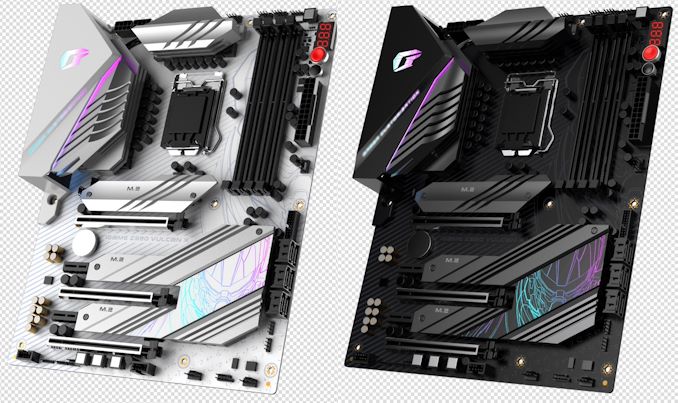
Apologies about the background; this is how we received the images from Colorful.
The Colorful iGame Z590 Vulcan X and W include three full-length PCIe slots, including two operating at PCIe 4.0 x16 and x8/x8, the third full-length slot locked to PCIe 3.0 x4 and surrounds two PCIe 3.0 x1 slots. There are three M.2 slots for storage, one PCIe 4.0 x4 and two PCIe 3.0 x4/SATA, with six SATA ports with support for RAID 0, 1, 5, and 10.
We did get sent a specifications list from Colorful, but it wasn't too detailed. As such, it didn't specify memory compatibility or what HD audio codec the board is using. We do know though that both model's rear panel includes one USB 3.2 G2x2 Type-C, three USB 3.2 G2 Type-A, four USB 3.2 G1 Type-A, one HDMI video output, and one HDMI video output. Colorful uses an Intel I225-V 2.5 GbE controller and an Intel AX210 Wi-Fi 6E CNVi with support for BT 5.2 devices on the networking side of things.
At this time, Colorful hasn't given us any pricing information, but we will keep this page updated when we know more.
Colorful CVN Z590 Gaming Pro & Frozen V20
At the time of writing, we have been made aware that the Colorful CVN Z590 Gaming Pro and CVN Z590 Frozen V20 will be announced at some stage. However the case, we have no details about it and this page is a placeholder for when those details are shared with us.
Colorful CVN Z590M Gaming Pro & Frozen V20
At the time of writing, we have been made aware that the Colorful CVN Z590M Gaming Pro and CVN Z590M Frozen V20 will be announced at some stage. However the case, we have no details about it and this page is a placeholder for when those details are shared with us.
EVGA Z590 Dark
EVGA plans to unveil a pair of new models. The first is the very recognizable EVGA Z590 Dark, which targets extreme overclockers and enthusiasts with deep pockets. The most notable design traits include an overclocker's toolkit in the top right-hand corner, including a pair of two-digit LED debuggers, a power switch, and a reset button.
At present, EVGA hasn't given us any technical details about the Z590 Dark, but we can see a couple of notable inclusions. There are eight SATA ports, including support for RAID 0, 1, 5, and 10 arrays, with two memory slots that will likely support some of the fastest DDR4 memory on the market. Designed more for overclockers looking to squeeze every last drop of performance from the silicon, the Z590 Dark has right-angled power connectors including two 8-pin 12 V EPS ATX power inputs for the CPU, with a 24-pin 12 V ATX delivering power to the board. It looks as though the board includes two full-length PCIe slots, with an open-ended half-length PCIe slot, with any M.2 slots likely to be located in between the full-length slots and under the large heatsink.
Once EVGA makes more details available, we will update this page.
EVGA Z590 FTW
The second board EVGA intends to launch sometime in 2021 is the EVGA Z590 FTW. Adopting a more gaming-inspired flavor than its Z590 Dark model, the FTW includes RGB LEDs within the rear panel cover and adopts a more conventionally styled all-black PCB. It includes a right-angled 24-pin 12 V ATX motherboard power connector, with a power and reset button pairing, with a two-digit LED debugger in the top right-hand corner.
Currently, EVGA hasn't provided any technical specifications, but we can see six SATA ports, two full-length PCIe slots, and a half-length PCIe slot located at the bottom. Any M.2 slots are likely to be underneath the large heatsink which dominates the lower portion of the board, with a PCIe 4.0 x4 slot likely to be under the silver M.2 heatsink in the center of the board. The Z590 EVGA FTW also has four memory slots, with a very subtle design and aesthetic throughout. There also seems to be a Wi-Fi module on the rear panel.
Once EVGA provides us with more information, we will update this page.
GIGABYTE Z590 Aorus Xtreme & Xtreme WaterForce
GIGABYTE's flagship for Z590 is the Aorus Xtreme, with an Xtreme WaterForce model for users with custom water cooling. GIGABYTE has gone for a darker look for Z590 when compared to the Z490 Aorus Xtreme, with an all-black aesthetic that looks clean and stylish. The Z590 Aorus Xtreme WaterForce uses a large custom monoblock, which provides cooling to the CPU and the board's large 20+1 phase power delivery. The general design includes RGB LED lighting, which is installed into the rear panel cover and chipset heatsink.
At the top right-hand corner is a two-digit LED debugger, with a power and reset button embedded within a panel covering a right-angled 24-pin 12 V ATX power input. Covering the rest of the PCB is a plethora of black PCIe armor, which blends the M.2 heatsinks into the design. Coated with armor reinforcement, the Z590 Aorus Xtreme includes three full-length slots with two PCIe 4.0 that can operate at x16 or x8/x8, with a third slot electronically locked down to PCIe 3.0 x4. GIGABYTE includes four memory slots capable of supporting up to DDR4-5000, with a total capacity of up to 128 GB across four memory slots. For storage, GIGABYTE includes three M.2 slots, with one operating at PCIe 4.0 x4, two at PCIe 3.0 x4, with six SATA ports offering support for RAID 0, 1, 5, and 10 arrays.
On the rear panel of both the Z590 Aorus Xtreme and Xtreme WaterForce is dual Thunderbolt 4 Type-C, with eight USB 3.2 G2 Type-A ports and one HDMI video output. A Realtek ALC1220-VB HD audio codec and ESS Sabre ES9018K2M DAC power the five 3.5 mm audio jacks and S/PDIF optical output, while at the left-hand side, GIGABYTE has included a Clear CMOS and Q-Flash Plus button. Finishing off the rear panel is a pair of Ethernet ports, one through an Aquantia 10 GbE controller and the other by an Intel I225-V 2.5 GbE controller, with antenna ports for Intel's AX210 Wi-Fi 6E CNVi.
At the time of writing, GIGABYTE hasn't shared any details on its Z590 models' pricing.
GIGABYTE Z590 Aorus Master
The next model down from the Aorus Xtreme is the GIGABYTE Z590 Aorus Master. It is an ATX board with a premium feature set including Aquantia 10 GbE, Wi-Fi 6E, and three PCIe M.2 slots. The design is similar to the previous Z490 version, with black and gray heatsinks covering most of the board's PCB. It features integrated RGB into the etchings on the rear panel cover that resembles claw marks, with an RGB enabled Aorus Falcon logo on the chipset heatsink.
Towards the board's center are three full-length PCIe slots, with two operating at PCIe 4.0 x16 and x8/x8, with the last one locked to PCIe 3.0 x4. GIGABYTE includes plenty of storage options, including three M.2 slots, one supporting PCIe 4.0 x4, with the other two limited to PCIe 3.0 x4 and SATA drives. Six SATA ports allow for RAID 0, 1, 5, and 10 arrays. GIGABYTE is currently supporting DDR4-5000, while users can install up to 128 GB across four available memory slots.
On the rear panel, GIGABYTE includes one USB 3.2 G2x2 Type-C, five USB 3.2 G2 Type-A, and four USB 3.2 G1 Type-A ports. A single Ethernet port is powered by an Aquantia 10 GbE controller with an Intel AX210 Wi-Fi 6E CNVi. Simultaneously, the five 3.5 mm audio jacks and S/PDIF optical output are driven by a Realtek ALC1220-VB HD audio codec and ESS Sabre ES9118 DAC. There is a pair of buttons, one for Q-Flash Plus and another for clearing the CMOS, while a single DisplayPort 1.2 video output offers users access to Intel's HD integrated graphics.
At the time of writing, GIGABYTE hasn't shared any details on its Z590 models' pricing.
GIGABYTE Z590 Aorus Pro AX
Sitting between the Aorus Master and Elite in GIGABYTE's new Z590 range, the GIGABYTE Z590 Aorus Pro AX advertises a direct 12+1 phase power delivery, with premium 90 A power stages, with four M.2 slots and an Intel 2.5 GbE and Wi-Fi 6 network pairing. Like other Aorus branded models, the Z590 Aorus Pro AX follows GIGABYTE's typical black and gray color theme throughout, with an integrated thin RGB LED strip in the rear panel cover and M.2 heatsinks covering all the available slots.
Included are three full-length PCIe slots with two operating at PCIe 4.0 x16 and x8/x8, with the third operating at PCIe 3.0 x4. Storage options include four M.2 slots, with two PCIe 4.0 x4 and two PCIe 3.0 x4/SATA M.2, as well as six SATA ports with support for RAID 0, 1, 5, and 10 arrays. The Z590 Aorus Pro AX includes four memory slots with support for DDR4-5000, with a maximum of up to 128 GB.
GIGABYTE uses the latest Realtek ALC4080 HD audio codec, which powers the board's five 3.5 mm audio jacks and S/PDIF optical output. There's an Intel I225-V 2.5 GbE controller and an Intel AX200 Wi-Fi 6 CNVi with support for BT 5.0 devices for networking. There's also plenty of USB connectivity too, with one USB 3.2 G2x2 Type-C, four USB 3.2 G2 Type-A, four USB 3.2 G1 Type-A, and four USB 2.0 ports. Finishing off the rear panel is a single DisplayPort 1.2 video output.
At the time of writing, GIGABYTE hasn't shared any details on its Z590 models' pricing.
GIGABYTE Z590 Aorus Elite & Elite AX
Representing the mid-range of Intel's Z590 chipset is the GIGABYTE Z590 Aorus Elite, and the Wi-Fi 6 enabled Z590 Aorus Elite AX. Aside from the Intel Wi-Fi 6 CNVi, both models are identical in design and aesthetics, with an advertised 12+1 phase power delivery, with support for 128 GB of DDR4-5000 on an ATX PCB. The design follows a simple black and silver color scheme, with RGB LEDs built into the Aorus logo at the bottom of the chipset heatsink.
The GIGABYTE Z590 Aorus Elite and Elite AX include two full-length PCIe slots, the top one supporting up to PCIe 4.0 x16, while the bottom slot is locked to PCIe 3.0 x4, with one PCIe 3.0 x1 slot also present. For storage, the Elite pairing includes two M.2 slots, one PCIe 4.0 x4 M.2 slot with a heatsink, and a second slot supporting both PCIe 3.0 x4, and SATA drives. GIGABYTE also includes six SATA ports with support for RAID 0, 1, 5, and 10 arrays for more conventional storage devices. A total of four memory slots located in the top right-hand corner allow for up to DDR4-5000, with a combined total capacity of up to 128 GB.
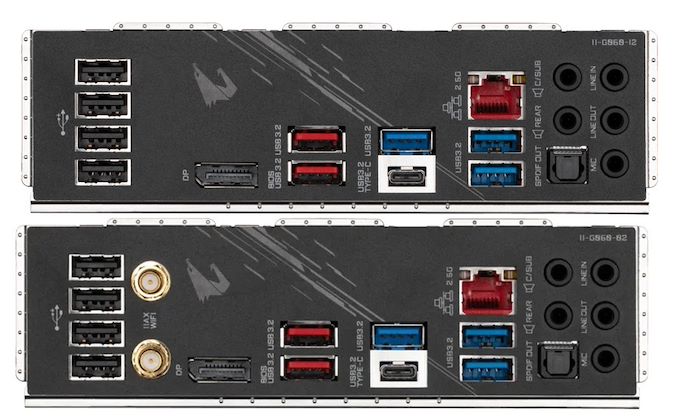
The GIGABYTE Z590 Aorus Elite (top) and Z590 Aorus Elite AX (bottom) rear panels
Both the GIGABYTE Z590 Aorus Elite and Elite AX models include one USB 3.2 G2x2 Type-C, five USB 3.2 G2 Type-A, and four USB 2.0 ports, with a single DisplayPort 1.2 video output. A Realtek ALC1220-VB HD audio codec powers five 3.5 mm audio jacks and S/PDIF optical output, while GIGABYTE includes a Realtek RTL8125 2.5 GbE controller. On the Z590 Aorus Elite AX, GIGABYTE uses an Intel AX201 Wi-Fi 6 CNVi with support for BT 5.1 devices. The middle red bottom USB port, with what says BIOS next to it, would be the BIOS flashing port.
At the time of writing, GIGABYTE hasn't shared any details on its Z590 models' pricing.
GIGABYTE Z590I Aorus Ultra
The GIGABYTE Z590I Aorus Ultra represents a small handful of mini-ITX boards so far announced for Z590, and it has got a pretty impressive feature set. GIGABYTE's mini-ITX offerings have been getting better and better over the years. The Z590I Aorus Ultra includes dual PCIe M.2 slots, a premium HD audio codec, as well as an Intel 2.5 GbE and Wi-Fi 6 network pairing.
Included in the specifications, GIGABYTE is advertising a direct 10+1 phase power delivery, with support for DDR4-5000 and up to 64 GB across two available memory slots. Along the bottom is a full-length PCIe 4.0 x16 slot, with multiple storage options, including one PCIe 4.0 x4 M.2 slot, one PCIe 3.0 x4/SATA M.2 slot, and four SATA ports. The PCIe 4.0 x4 M.2 slot is located on the front under a combined M.2 and chipset heatsink, while the PCIe 3.0 x4/SATA port is located on the back of the board. Design-wise, GIGABYTE uses its black and gray color scheme, which is a mainstay of the Aorus range, with a strip of RGB LED's located on the right-hand side of the board.
The rear panel includes one USB 3.2 G2x2 Type-A, three USB 3.2 G2 Type-A, two USB 3.2 G1 Type-A, and two USB 2.0 ports. An Intel I225-V 2.5 GbE controller drives the single RJ45 port, while there are two antenna ports for the Intel AX200 Wi-Fi 6 CNVi, which includes support for BT 5.0 devices. The GIGABYTE uses a Realtek ALC1220-VB HD audio codec to power the three 3.5 mm audio jacks, while it also includes a DisplayPort and HDMI video output pairing. Finishing off the rear panel is a small Q-Flash Plus button for users looking to flash the board's firmware.
At the time of writing, GIGABYTE hasn't shared any details on its Z590 models' pricing.
GIGABYTE Z590 Gaming X
GIGABYTE's Aorus gaming series targets the mid-range. Still, for entry-level users looking for gaming-specific features, there's the Z590 Gaming X. Despite sitting towards the bottom of GIGABYTE's stack of gaming models, the Z590 Gaming X is advertised with a direct 12+1 phase power delivery, three M.2 slots, as well as Intel's 2.5 GbE controller.
The GIGABYTE Z590 Gaming X follows a modern black and brushed steel design, with LED's built onto the board in the top right and bottom right corners. The rear panel cover, M.2, and chipset heatsinks include a black contrasting design on a silver background, with an all-black PCB.
Towards the board's center and bottom are two full-length PCIe slots, with the top slot operating at PCIe 4.0 x16, and the bottom slot locked down to PCIe 3.0 x4, with two PCIe 3.0 x1 slots. For storage, the Z590 Gaming X includes three slots in total. The top M.2 slot operates a PCIe 4.0 x4, while the central and bottom M.2 slots have support for PCIe 3.0 x4 and SATA drives. The board also includes six SATA ports with support for RAID 0, 1, 5, and 10 arrays located in an X-shaped cutout. In the top-right hand corner is four memory slots with users able to install up to 128 GB, but GIGABYTE hasn't at this time released its QVL list, so for now, memory is only listed at DDR4-3200.
The rear panel includes one USB 3.2 G2 Type-C, one USB 3.2 G2 Type-A, five USB 3.2 G1 Type-A, and two USB 2.0 ports. Powering the single RJ45 port is a Realtek RTL8125 2.5 GbE controller, with an unspecified Realtek HD audio codec driving the board's six 3.5 mm audio jacks. Finishing off the rear panel is a DisplayPort video output and PS/2 keyboard and mouse combo port.
At the time of writing, GIGABYTE hasn't shared any details on its Z590 models' pricing.
GIGABYTE Z590 Vision G
Moving away from GIGBAYTE's gaming-focused Z590 models, its Vision series is designed for content creators, focusing on performance and creativity. Although any Z590 model will generally perform within the limitations of the processor installed, the GIGABYTE Z590 Vision G brings GIGABYTE's VisionLink into play, which allows plenty of functionality surrounding the USB Type-C ports. It follows a very light aesthetic with white and silver heatsinks and purple accented strips on the rear panel cover and just above the chipset heatsink for some color contrast.
The Z590 Vision G includes three full-length PCIe slots, with the top slot operating at PCIe 4.0 x16, and the other two at PCIe 3.0 x4. The full-length slots' restrictions reflect the impressive storage options, with four M.2 slots, two operating at PCIe 4.0 x4 and the other two at PCIe 3.0 x4, with six SATA ports that include support for RAID 0, 1, 5, and 10 arrays. At the time of writing, GIGABYTE hasn't released the QVL list for the Z590 Vision G, so memory is listed at Intel spec DDR4-3200, although there are four memory slots with support for up to 128 GB. While many models on Z590 are utilizing the native USB 3.2 G2x2 support, GIGABYTE adds one USB G2x2 Type-C front panel header on top of what's on the rear panel.
On the rear panel is a pair of USB 3.2 G2x2 Type-C ports with a single DisplayPort video input, with a further two USB 3.2 G2 Type-A, four USB 3.2 G1 Type-A, and two USB 2.0 ports. The GIGABYTE Z590 Vision G includes an Intel I225-V 2.5 GbE controller, with six 3.5 mm audio jacks powered by Realtek's latest ALC4080 HD audio codec. For users planning on using Intel's integrated graphics, there's a single HDMI video output, and last but not least, GIGABYTE includes a PS/2 keyboard and mouse legacy input.
At the time of writing, GIGABYTE hasn't shared any details on its Z590 models' pricing.
GIGABYTE Z590 Vision D
The GIGABYTE Z590 Vision D is the top tier model in its line up for creators, with exquisite silver and black contrasting design. Like GIGABYTE's Designare models, which focus on premium controller sets utilized by creators and designers, the Z590 Vision D includes Thunderbolt 4 Type-C, three PCIe M.2 slots, dual 2.5 GbE, and Wi-Fi 6E networking. In the top-right hand corner is a two-digit LED debugger, with a wave of PCIe slot armor that matches the design of the rear panel cover and the power delivery heatsink covers.
Looking towards the center of the board sits the PCIe area, with three full-length PCIe slots operating at PCIe 4.0 x16, and x8/x8. The third slot is locked at PCIe 3.0 x4, with a single PCIe 3.0 x1 slot. The GIGABYTE offers three M.2 slots, with one PCIe 4.0 x4 and two PCIe 3.0/SATA, with six SATA ports for conventional drives with support for RAID 0, 1, 5, and 10 arrays. As it stands, GIGABYTE hasn't given us the QVL list for memory support, so it's listed at Intel's default DDR4-3200 spec, although the four memory slots can accommodate up to 128 GB. Like the Z590 Vision G, the GIGABYTE Z590 Vision D includes a USB 3.2 G2x2 Type-C internal header.
The GIGABYTE Z590 Vision G has a premium rear panel, with two Thunderbolt 4 Type-C ports supported with a DisplayPort input and two USB 3.2 G2 Type-A and four USB 3.2 G1 Type-A ports. Realtek's latest ALC4080 HD audio codec makes an appearance and drives the five color-coded 3.5 mm audio jack and S/PDIF optical output. In contrast, an HDMI video output offers users support for Intel's HD integrated graphics. Finishing off the rear panel is a pair of Intel I225-V 2.5 GbE controllers, with Intel's latest AX210 Wi-Fi 6E CNVi, which also includes support for BT 5.2 devices.
At the time of writing, GIGABYTE hasn't shared any details on its Z590 models' pricing.
GIGABYTE Z590I Vision D
Based on its larger ATX sibling, the Z590 Vision D, the GIGABYTE Z590I Vision D follows similar principles in that it is designed for content creators but for those that require a small desktop footprint. Aside from its small form factor mini-ITX design, it uses silver and black contrasting heatsinks and packs a mighty punch in the features department. It includes dual Thunderbolt 4 Type-C, Intel's 2.5 Gb Ethernet, as well as Wi-Fi 6 and dual PCIe 4.0 x4 M.2.
Located along the bottom of the board is a single full-length PCIe 4.0 x16 slot, with solid storage options including dual PCIe 4.0 x4 M.2, as well as four straight angled SATA ports that include support for RAID 0, 1, 5, and 10. GIGABYTE hasn't unveiled memory compatibility, so things currently stand at DDR4-3200, although users can still install up to 64 GB of memory across two slots.
The rear panel is impressive for a mini-ITX model, with dual Thunderbolt 4 Type-C and DisplayPort input and two USB 3.2 G2 Type-A and four USB 3.2 G1 Type-A ports. Networking includes Intel's I225-V 2.5 GbE controller and Intel AX210 Wi-Fi 6E CNVi pairing, with just two 3.5 mm audio jacks line-out and another for a microphone. Last but not least is a small Q-Flash button that allows users to update the board's firmware.
At the time of writing, GIGABYTE hasn't shared any details on its Z590 models' pricing.
GIGABYTE Z590 UD & Z590 UD AC
Touted as GIGABYTE's entry-level Z590 models, both the Z590 UD AC and Z590 UD share the same PCB, and as a result, follows the same black and white design. This includes a black and white printed PCB, with black heatsinks and a slim rear panel cover. The GIGABYTE Z590 UD AC includes Wi-Fi 5 802.11ac support, with both models including three PCIe M.2 slots, 2.5 Gb Ethernet, and advertised as having a 12+1 phase power delivery.
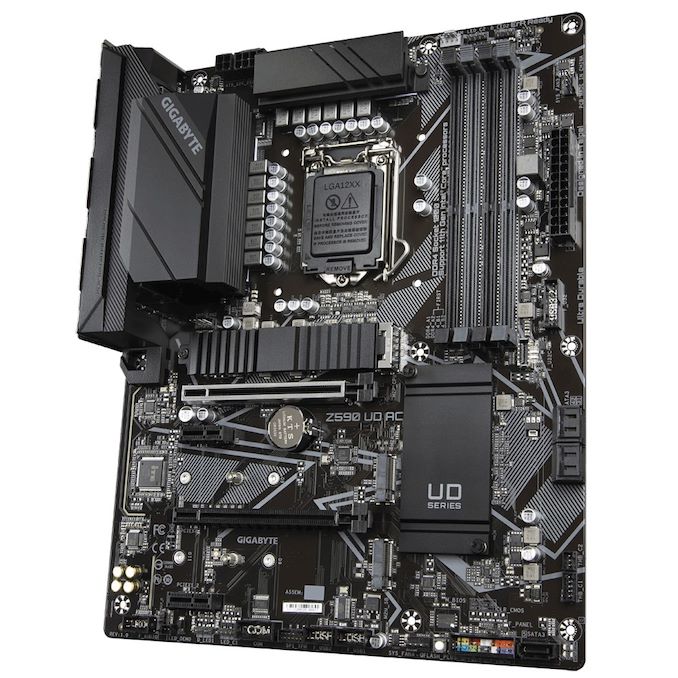
The GIGABYTE Z590 UD AC motherboard
Both the Ultra Durable (UD) models include two full-length PCIe slots, with the top operating at PCIe 4.0 x16, and the second at PCIe 3.0 x4, and a single PCIe 3.0 x1 slot located at the bottom. Bordering on one of the most basic models of any Z590 board announced so far, GIGABYTE includes one PCIe 4.0 x4 and one PCIe 3.0 x4/SATA M.2 slot, with five SATA ports with RAID 0, 1, 5, and 10 support. Four of the SATA include right-angled ports at the right-hand side of the board, while a single straight-angled port is located in the bottom right-hand corner. The Z590 UD AC and Z590 UD include four memory slots with support for up to 128 GB, with GIGABYTE not unveiling the maximum supported speeds at this time.
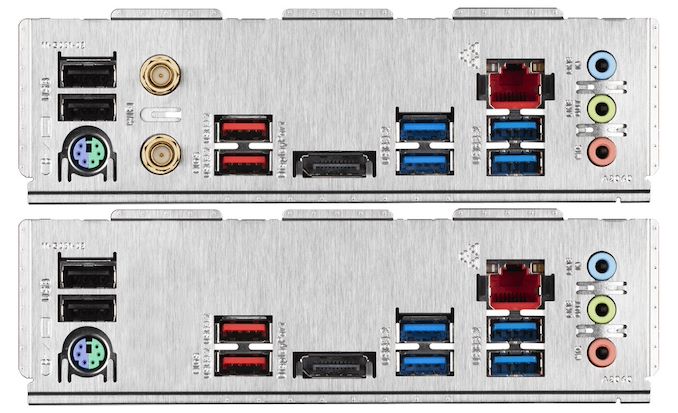
The GIGABYTE Z590 UD AC (top) and Z590 UD (bottom) rear panels
The only difference between both models is the inclusion of a Wi-Fi 5 CNVi on the AC model on the rear panel. Both models include two USB 3.2 G2 Type-A, four USB 3.2 G1 Type-A, and two USB 2.0 ports and omits any kind of Type-C connectivity, likely to save on costs. A single DisplayPort video output, three 3.5 mm audio jacks, an unspecified 2.5 GbE controller, and a PS/2 combo port finish up the rest of the rear panel. GIGABYTE also includes a nice metallic silver I/O shield.
At the time of writing, GIGABYTE hasn't shared any details on its Z590 models' pricing.
MSI MEG Z590 Godlike
The MSI MEG Z590 Godlike is the flagship model from its premium MEG (MSI Extreme Gaming) series and is designed to target performance users and enthusiasts. It uses a new fresh metallic inspired design throughout, with a black PCB, black and silver styled armor, with its Dynamic Dashboard II dominating the aesthetic. The integrated OLED panel can display critical elements such as CPU VCore, CPU Core clock speed, among other useful information. The Godlike also benefits from subtle RGB LED lighting built into the large Dragon infused rear panel cover and the elegantly designed chipset heatsink. On the right-hand side, MSI includes its Dynamic Dashboard II OLED panel.
Among the waves of black and silver armor, the Z590 Godlike includes three full-length PCIe slots, with the top two of these operating at PCIe 4.0 x16 and x8/x8, with the third slot hidden by a strip of black armor electronically locked down to PCIe 3.0 x4. Offering the fastest memory support out of the box, users can install up to DDR4-5333 memory, with up to 128 GB of capacity across four memory slots. There's also plenty of storage input for users to sink their teeth into with four M.2 slots in total, including one PCIe 4.0 x4 and three PCIe 3.0 x4/SATA M.2 slots. This also includes six SATA ports with support for RAID 0, 1, 5, and 10 arrays. MSI is advertising one of its biggest desktop VRMs with its direct 20-phase power delivery.
The rear panel includes a generous selection of input and output, including two Thunderbolt 4 Type-C ports, each with its own mini DisplayPort passthrough port. Other USB connections include two USB 3.2 G2 10 Gbps Type-A and six USB 3.2 G1 Type-A ports. MSI uses a premium networking configuration on the Z590 Godlike, which includes two Ethernet ports, with one driven by Aquantia AQC107 10 GbE controller and the other by an Intel I225-V 2.5 GbE controller. The Godlike is also using Intel's latest Wi-Fi 6E CNVi, the Intel AX210. Finishing off the rear panel are five 3.5 mm audio jacks and S/PDIF optical output controlled by a Realtek ALC1220 HD audio codec, a Clear CMOS button, as well as a BIOS Flashback button.
For all the Godlike offers, MSI has set an MSRP of $1019, which is pretty standard for a flagship in the current climate (Ian: still very crazy). The accessories bundle includes MSI's Gen4 M.2 Xpander-Z M.2 add-on card, a set of DIY stands, and an MSI Tuning controller for overclockers hardcore enthusiasts. This also adds to the cost, but the MSI MEG Z590 Godlike has plenty of premium controllers with 10 GbE, Wi-Fi 6E, and it looks new instead of a direct refresh from the previous generation.
MSI MEG Z590 Ace & Z590 Ace Gold Edition
The MSI MEG Z590 Ace and MEG Z590 Ace Gold Edition both represent its enthusiast gaming series and sits just below the Godlike in both specifications and overall presentation. MSI has opted for a primarily black design with gold accents at various points of the board, including the power delivery and top M.2 heatsink, with more gold text on the audio PCB cover. It includes a stylish illuminated RGB MSI Dragon logo built into the rear panel cover, with more RGB LED's located within the bottom mesh of the chipset heatsink.
The only difference between the Z590 Ace and Z590 Ace Gold Edition is the aesthetic, with the latter decked out in gold and aluminum instead of black. The rest of the feature and controller set remains the same.
The MSI MEG Z590 Ace is stacked with features, including three full-length PCIe slots, with two operating at PCIe 4.0 x16 and x8/x8, with the bottom full-length slot locked to PCIe 3.0 x4. MSI includes plenty of storage options, including four M.2 slots, one PCIe 4.0 x4, and three PCIe 3.0 x4/SATA, with six SATA ports with RAID 0, 1, 5, and 10 support. Going all out on memory capabilities, the Z590 Ace includes four memory slots, with support for up to DDR4-5333 and up to 128 GB.
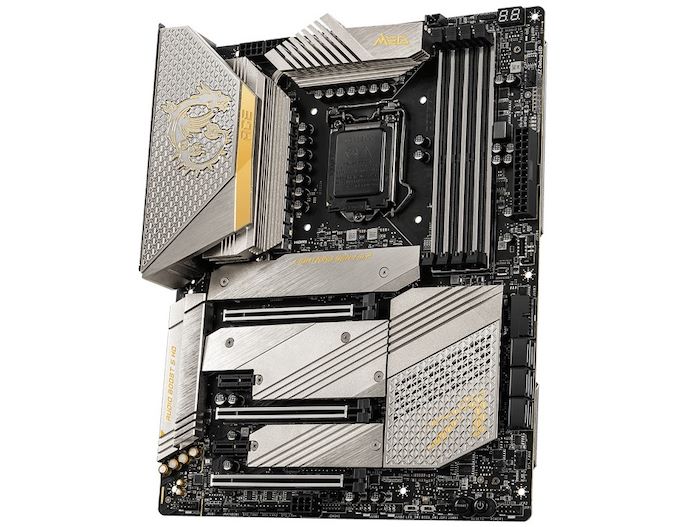
The MSI MEG Z590 Ace Gold Edition which was announced alongside Rocket Lake
In the top right-hand corner is a two-digit LED debugger, while a power and reset button pairing is located in the bottom right-hand corner. MSI is advertising a 16+2 phase power delivery that uses doublers, with a pair of 8-pin 12 V ATX CPU power inputs.
On the rear panel are a pair of Thunderbolt 4 Type-C ports with two mini-DisplayPort passthrough inputs, two USB 3.2 G2 Type-A, four USB 3.2 G1 Type-A, and two USB 2.0 ports. A single HDMI video output allows users to utilize Intel's HD graphics, while a Realtek HD audio codec drives five 3.5 mm audio jacks and S/PDIF optical output. MSI uses Intel's I225-V 2.5 GbE controller, with the latest Intel AX210 Wi-Fi 6E CNVi, with support for BT 5.2 devices. Last but certainly not least, the Z590 Ace includes a clear CMOS button and a BIOS Flashback button to allow users an easy alternative to flash the board's firmware.
As it stands, MSI has an MSRP of $489 set for the MEG Z590 Ace, which is around $80 more than when it released the Z490 version. It does include a host of premium features and includes dual Thunderbolt 4 Type-C.
MSI MEG Z590 Unify
At the time of writing, we have been made aware that the MSI MEG Z590 Unify will be announced at a later date. However the case, we have no details about it and this page is a placeholder for when those details are shared with us.
MSI MEG Z590 Unify-X
At the time of writing, we have been made aware that the MSI MEG Z590 Unify-X will be announced at a later date. However the case, we have no details about it and this page is a placeholder for when those details are shared with us.
MSI MEG Z590I Unify
One of MSI's premium ranges is the Unify, with subtle and classic all-black aesthetics that omit integrated RGB lighting. The smallest of its trio of Unify boards is the MSI MEG Z590I Unify with its mini-ITX form factor, with plenty of premium features, including a 10-layer PCB. It uses all-black heatsinks, with a black dragon embossed onto the rear panel cover, and has a combination M.2 and chipset heatsink.
Due to its mini-ITX form factor, the board has a single full-length PCIe 4.0 x16 slot, but it is also equipped with two M.2 slots, one operating at PCIe 4.0 x4 and another with support for PCIe 3.0 x4 and SATA drives. Along the right-hand side is four straight-angled SATA ports, which sit next to two memory slots with support for up to DDR4-5600 memory and up to 64 GB of capacity. MSI is advertising a direct 8+1 phase power delivery, with premium 90 A power stages throughout, with a single 8-pin 12 V ATX CPU power input delivering power to the CPU.
On the rear panel, the MSI MEG Z590I Unify includes two Thunderbolt 4 Type-C ports with two mini-DisplayPort video inputs, two USB 3.2 G2 Type-A, two USB 3.2 G1 Type-A, and two USB 2.0 ports. Powering the networking side is an Intel I225-V 2.5 GbE controller and Intel AX210 Wi-Fi 6E CNVi, while the three 3.5 mm audio jacks are driven by a Realtek ALC1220P HD audio codec. Finishing off the rear panel is a clear CMOS button and a pair of video outputs, including one HDMI 2.0b and one DisplayPort 1.4. output.
MSI MPG Z590 Gaming Carbon WiFi
A mainstay from the MPG performance gaming series, the MSI MPG Z590 Gaming Carbon WiFi is using a carbon fiber inspired design throughout. Opting for a more aggressive and futuristic look compared to its Z490 Gaming Carbon WiFi model. From the black PCB to the black and slightly dark grey heatsinks throughout its design, MSI looks to stamp a new style to its motherboard range. Notably, the heatsink fan array on the power delivery heatsink is very striking, with an RGB-enabled rear panel cover, and more RGB LEDs integrated into the chipset heatsink.
The MSI MPG Z590 Gaming Carbon WiFi doesn't just look fresh, but it has some very impressive features. This includes three full-length PCIe slots, with two operating at PCIe 4.0 x16 and x8/x8, with the other operating at PCIe 3.0 x4. There is also one PCIe 3.0 x1 slot, with a trio of M.2 slot heatsinks flanking the PCIe slot area. MSI includes one PCIe 4.0 x4 M.2 slot, with two PCIe 3.0 x4/SATA slots, with six SATA ports offering support for RAID 0, 1, 5, and 10 arrays. There is also support for up to DDR4-5200 memory, with a total combined capacity of up to 128 GB available across four memory slots.
On the rear panel is a single USB 3.2G2x2 Type-C port, with three USB 3.2 G2 Type-A, two USB 3.2 G1 Type-A, and four USB 2.0 ports. There is one DisplayPort and an HDMI video output pairing for users looking to leverage Intel's integrated graphics. A Realtek ALC1220 HD audio codec powers five 3.5 mm audio jacks and S/PDIF optical output. MSI uses an Intel I225-V 2.5 GbE controller for word networking, while an Intel AX210 Wi-Fi 6E interface takes care of the wireless and adds support for BT 5.2 devices.
Representing the mid-range, the MSI MPG Z590 Gaming Carbon WiFi has an MSRP of $324. The MPG series is catered towards the mid-range of the Z590 market, and it has plenty of features to make it a solid option, including USB 3.2 G2x2 Type-C, 2.5 GbE, and Wi-Fi 6E.
MSI MPG Z590 Gaming Force
A new addition to its MPG series, MSI has unveiled the MPG Z590 Gaming Force. As aggressive in nature, as it sounds, it is using a very unorthodox color scheme with metallic purple and gold heatsinks on a black PCB. Resembling something out of Gundam, MSI is advertising a premium 16-phase power delivery for the CPU, with a pair of 8-pin 12 V ATX CPU power inputs, with a two-digit LED debugger located in the top-right corner.
The MSI MPG Z590 Gaming Force uses three full-length PCIe slots, with the top two operating at PCIe 4.0 x16 and x8/x8, and the third one operating at PCIe 3.0 x4, with two additional PCIe 3.0 x1 slots. Looking at storage options, it includes one PCIe 4.0 x4 M.2 slot, with two PCIe 3.0 x4/SATA M.2 slots, each of them covered by its own fancy purple and yellow accented heatsink. The board also includes six SATA ports with support for RAID 0, 1, 5, and 10. Located along the bottom of the PCB is a 6-pin 12 V GPU power input, which is designed to provide more power to the PCIe slots, although this is a very niche inclusion and is not entirely necessary.
On the rear panel is one USB 3.2 G2x2 Type-C, three USB 3.2 G2 Type-A, two USB 3.2 G1 Type-A, and four USB 2.0 ports. For networking, it includes an Intel I225-V 2.5 GbE controller. The onboard audio configuration consists of five 3.5 mm audio jacks and S/PDIF optical output, which is powered by an unspecified Realtek HD audio codec. A small BIOS Flashback button is located on the left-hand side, while users looking to utilize Intel HD graphics can the DisplayPort 1.4 and HDMI 2.0 video output pairing.
The MPG Z590 Gaming Force is a new MSI model and looks to be inspired by the legendary Gundam with its purple and gold color scheme. It has a solid mid-range controller set, with a reasonable MSRP price of $314.
MSI MPG Z590 Gaming Edge WIFI
At the time of writing, we have been made aware that the MSI MPG Z590 Gaming Edge WiFi will be announced at a later date. However the case, we have no details about it and this page is a placeholder for when those details are shared with us.
MSI MPG Z590M Gaming Edge WiFi
At the time of writing, we have been made aware that the MSI MPG Z590M Gaming Edge WiFi will be announced at a later date. However the case, we have no details about it and this page is a placeholder for when those details are shared with us.
MSI MPG Z590 Gaming Plus
At the time of writing, we have been made aware that the MSI MPG Z590 Gaming Plus will be announced at a later date. However the case, we have no details about it and this page is a placeholder for when those details are shared with us.
MSI MAG Z590 Tomahawk WIFI
The Tomahawk series has been well regarded as one of the most cost-effective boards when considering both features and price points. For Z590, MSI looks to have gone a slightly different route and equipped it towards the mid-range, with plenty of competitive controllers and specifications. The MSI MAG Z590 Tomahawk is advertised with a large 16-phase power delivery and follows a black and dark gray color scheme throughout. MSI has gone as far as numbering its M.2 heatsinks, which resembles a militaristic theme that is fitting, as it hails from its Arsenal gaming series.
The MSI MAG Z590 Tomahawk's features include two full-length PCIe slots, with one full-length PCIe 4.0 x16, a second full-length PCIe 3.0 x4 slot, and two PCIe 3.0 x1 slots. Similar to its MPG series of boards, the Z590 Tomahawk WiFi has three M.2 slots, each with heatsinks, and includes one PCIe 4.0 x4 and two PCIe 3.0 x4/SATA slots. MSI splits up the location of the SATA ports, with four right-angled connectors in an X-shaped cutout on the PCB, with two straight-angled ports located at the bottom. All six of the SATA ports include support for RAID 0, 1, 5, and 10 arrays. Memory support is impressive, with speeds of up to DDR4-5333 and up to 128 GB of capacity across four memory slots.
The MSI MAG Z590 Tomahawk WiFi includes one USB 3.2 G2x2 Type-C, one USB 3.2 G2 Type-A, four USB 3.2 G1 Type-A, and two USB 2.0 ports. MSI includes a premium Intel pairing with its latest AX210 Wi-Fi 6E interface and a single I225-V 2.5 GbE controller for networking. Onboard audio is powered by an unspecified Realtek HD audio codec, with five 3.5 mm audio jacks and S/PDIF optical output included. Two video outputs include one DisplayPort 1.4 and one HDMI 2.0b. Finishing off the rear panel, which includes a pre-attached I/O shield, is a tiny BIOS Flashback button.
MSI has set an MSRP of $239 for the MAG Z590 Tomahawk WiFi, which is more than it was for the launch of Z490. Despite this, the Tomahawk is no longer a bridge between the entry-level and the mid-range; it's a solid mid-range model. It has plenty to offer for the price, including premium 2.5 GbE and Wi-Fi 6E networking, as well as three M.2 slots and USB 3.2 G2x2 Type-C.
MSI MAG Z590 Torpedo
Over the years, we've seen motherboard vendors have tried out new styles and aesthetics. Some have turned into successful ranges, such as ASRock's Taichi. MSI has announced a new model to its MAG Arsenal Gaming series called the Torpedo, which aims to sink the competition with a new color scheme similar to ASRock's Extreme series of boards. The MSI MAG Z590 Torpedo uses dark metallic blue throughout, including on the rear panel cover, heatsinks, and two of the four memory slots. It also includes integrated RGB LEDs built into the chipset heatsink and has a follows a militaristic theme.
The MSI MAG Z590 Torpedo has two full-length slots, with the top slot featuring support for PCIe 4.0 x16, the second slot locked down to PCIe 3.0 x4, and two additional PCIe 3.0 x1 slots. For storage, the Torpedo has three M.2 slots with one operating at PCIe 4.0 x4, and two with support for both PCIe 3.0 x4 and SATA, with six SATA ports capable of RAID 0, 1, 5, and 10. The board has four memory slots with up to 128 GB of capacity, but MSI hasn't provided any QVL lists at present, so JEDEC spec is listed at DDR4-3200.
On the rear panel is one USB 3.2 G2x2 Type-C, one USB 3.2 G2 Type-A, four USB 3.2 G1 Type-A, and two USB 2.0 ports. The board uses dual RJ45, coming via an Intel I225-V 2.5 GbE controller, and the other one by an Intel I219-V Gigabit one. A total of five 3.5 mm audio jacks and S/PDIF optical output are driven by a Realtek ALC4080 HD audio codec. In contrast, a DisplayPort and HDMI video output pairing allows users to benefit from Intel's integrated HD graphics. Finishing off the rear panel is a small but handy BIOS Flashback button.
MSI Z590 Pro WiFi & Z590 A Pro
Moving down to the more professional and basic Pro series, the MSI Z590 A Pro and the Z590 Pro WiFi blend basic with stylish. It uses a black ATX sized PCB, with white straight lines patterning, and black/silver accented heatsinks. The only difference between both models is the inclusion of a Wi-Fi 6E CNVi.
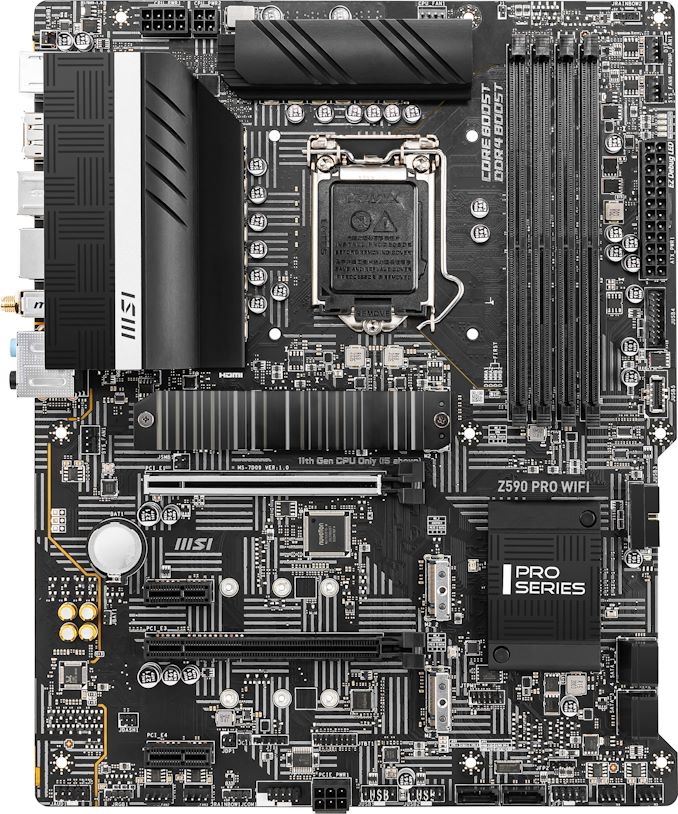
The MSI Z590 Pro WiFi motherboard
Dominating the lower portion of the board are two full-length PCIe slots, with the top slot operating at PCIe 4.0 x16, a second full-length slot locked down at PCIe 3.0 x4, and two PCIe 3.0 x1 slots. MSI includes plenty of storage connectivity, with one PCIe 4.0 x4 and two PCIe 3.0/SATA M.2 slots. There are also six SATA ports in total, with four straight angled with a cut-out into the PCB for better cable management and two straight-angled ports located at the bottom edge of the board. For memory, MSI includes four memory slots capable of installing up to 128 GB, with speeds of up to DDR4-5333.
On the rear panel is a single USB 3.2 G2 Type-C, one USB 3.2 G2 Type-A, two USB 3.2 G1 Type-A, and four USB 2.0 ports. The Wi-Fi variant includes an Intel AX210 Wi-Fi 6E CNVi, while both models include an Intel I225-V 2.5 GbE controller. MSI also includes a DisplayPort and HDMI video output pairing for users that intend to use Intel's integrated graphics. A PS/2 combo keyboard and mouse port and a small clear CMOS switch finish off the rear panel.
The MSI Z590 Pro WiFi has an MSRP of $209, while the Z590 A Pro has an MSRP of $189 which is currently the cheapest Z590 model we know about. Both models include a decent feature set for the price, and the Z590 Pro WiFi even includes 2.5 GbE and Wi-Fi 6E networking; the Z590 A Pro is the same board but without the Wi-Fi capability.
MSI Z590 Pro 12VO
At the time of writing, we have been made aware that the MSI Z590 Pro 12VO will be announced at a later date. However the case, we have no details about it and this page is a placeholder for when those details are shared with us. All we do know is that it will use the new 12VO power standard, and require a compatible power supply.
Supermicro C9Z590-CGW & C9Z590-CG
Supermicro is more commonly known for its workstation and server boards, but it does cater to the desktop market too with its SuperO series. It intends to release two ATX models for Z590, the C9Z590-CGW and C9Z590-CG, with the only difference is that the CGW model includes Wi-Fi 6. The design omits any form of RGB LED lighting and instead focuses on the essentials. Both models include a mixture of black, dark gray, and silver aesthetics on the rear panel cover and chipset heatsink, with solid black power delivery heatsinks keeping the VRMs cool.
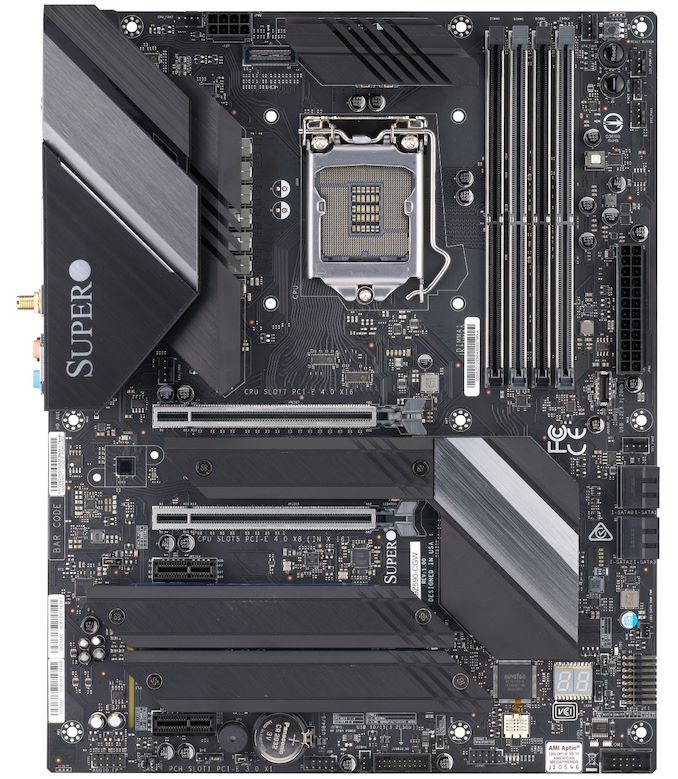
The Supermicro C9Z590-CGW motherboard with Wi-Fi 6
Both models include two full-length PCIe 4.0 slots, which run at x16, and x8/x8, with two PCIe 3.0 x1 slots. Memory support allows up to DDR4-4000, with up to 128 GB of capacity across four available memory slots. For storage, Supermicro includes three M.2 slots, including one PCIe 4.0 x4 and two PCIe 3.0 x4 slots, with four SATA ports capable of support RAID 0, 1, 5, and 10 arrays. The C9Z590-CGW and C9Z590-CG include a USB 3.2 G2x2 Type-C header, with one USB 3.2 G1 Type-A header (two ports), and one USB 2.0 headers (two ports). For cooling, Supermicro includes five 4-pin fan headers and a single DOM PW connector.
On the rear panel of the Supermicro C9Z590-CGW, it has two ports for the Wi-Fi 6 antenna, which is the only thing the CZ590-CG doesn't include. The rest of the panel is shared between both models, including two USB 3.2x2 Type-C, two USB 3.2 G1 Type-A, and four USB 2.0 ports. Supermicro typical installs premium networking, and both models feature an Aquantia AQC113C 10 GbE and Intel I219-V Gigabit controller pairing. The rest of the panel includes two video outputs, including HDMI 2.0a and DisplayPort 1.4, with five 3.5 mm audio jacks and S/PDIF optical output powered by a Realtek ALC1220 HD audio codec.
Supermicro hasn't shared any information on pricing with us so far.
ASUS ROG Strix Z590-I Gaming WIFI
The ASUS ROG Strix Z590-I Gaming WIFI is the brand's premium mini-ITX offering, with a true focus on high-end small form factor systems. It uses an all-black design, with elements of the ROG Strix design over a mesh-covered rear panel cover, with an RGB enabled ROG logo built unto the combined M.2 and chipset heatsink.
Along the bottom of the board is a single PCIe 4.0 x16 slot, with two stacked M.2 slots, with one operating at PCIe 4.0 x4, and the other with PCIe 3.0 x4/SATA support. The right-hand side is four straight-angled SATA ports, with support for RAID 0, 1, 5, and 10 arrays. Memory support is great as expected for an ASUS mini-ITX model, with speeds of up to DDR4-5333 and up to 64 GB of capacity. ASUS is also advertising a 10-phase power delivery in an 8+2 configuration, with one 8-pin 12 V ATX CPU power input delivering the necessary power to the processor.
On the rear panel are one Thunderbolt 4 Type-C port, with one USB 3.2 G2x2 Type-C, one USB 3.2 G2 Type-A, one USB 3.2 G1 Type-A, and four USB 2.0 ports. For users planning to take advantage of Intel's integrated graphics is an HDMI 2.0 video output, while three gold plated and illuminated 3.5 mm audio jacks are powered by a Realtek ALC4080 HD audio codec and Savitech SV3H712 amplifier. ASUS uses an Intel I225-V 2.5 GbE controller, with an Intel AX210 Wi-Fi 6E CNVi, which also adds BT 5.2 device connectivity. Finishing off the rear panel is a small BIOS Flashback button.
GIGABYTE Z590 Aorus Tachyon
At the time of writing, we have been made aware that the GIGABYTE Z590 Aorus Tachyon will be announced at some stage. However the case, we have no details about it and this page is a placeholder for when those details are shared with us.
GIGABYTE Z590 Aorus Ultra
The GIGABYTE Z590 Aorus Ultra is an ATX sized motherboard and caters towards the mid-range of the Z590 stack. GIGABYTE is advertising a 17-phase power delivery, organized into an 8+1 configuration with the CPU section doubling up on its 90 A power stages. Design-wise, the Z590 Aorus Ultra has a black PCB, with black and silver M.2 and chipset heatsinks, with an Aorus styled design built into the rear panel cover.
Towards the board's central and bottom area are three full-length PCIe slots, with the top two operating at PCIe 4.0 x16 and x8/x8, while the third full-length slot is locked at PCIe 3.0 x4. Storage options include one PCIe 4.0 x4 M.2, two PCIe 3.0 x4 M.2, and six SATA ports, with support for RAID 0, 1, 5, and 10. GIGABYTE is currently listing Intel spec memory support with DDR4-3200, but this is likely to be higher once GIGABYTE has published its QVL memory list. However, the four memory slots do include support for up to 128 GB. In the top-right hand corner of the board is a two-digit LED debugger.
The rear panel is one USB 3.2 G2x2 Type-C, four USB 3.2 G2 Type-A, four USB 3.2 G1 Type-A, and four USB 2.0 ports. For users looking to leverage Intel's HD integrated graphics, there's a single DisplayPort. There are five 3.5 mm audio jacks and S/PDIF optical output powered by Realtek's latest ALC4080 HD audio codec. The board's networking capabilities include an Intel I225-V 2.5 GbE controller, with an Intel AX200 Wi-Fi 6 CNVi, including support for BT 5.0 devices.
Choosing The Right Z590 Motherboard
It has become typical for any new processor launch from Intel or AMD to release a series of new chipsets. What the new chipsets do (for the most part) is allow users to access new features, new controllers (sometimes), and use any new refinements made. Intel's new Z590 chipset is designed for its Rocket Lake (11th generation) processors, which are set to launch later in Q1 2021. One of the biggest factors to consider when upgrading or building a new Intel-based system is that Z590 is backwards compatiblity with Intel's 10th gen Comet Lake processors. This allows users planning to move to Rocket Lake upon release to use the current processors until then.
One of the most notable features of Intel's Z590, which a lot of vendors have applied, is USB 3.2 G2x2 Type-C connectivity. It is even found on some vendor's lower-end options, including the MSI MAG Z590 Tomahawk WiFi ($239). The USB 3.2 G2x2 Type-C connectivity is now native to the chipset, whereas, on Z490, vendors had to implement additional ASMedia controllers (ASM3242) to accommodate this.
This is the same case for networking, with most models including 2.5 GbE (both Intel and/or Realtek, a couple Aquantia) as standard. We expect this to be a common trend for motherboards in the future. With this in mind, we've also seen the prices shift higher, which is a mixture of better controllers, features, PCIe 4.0, COVID-19, tariff relief ending, shipping charges, and perhaps a small uptick from Intel as well. All these push up the price. It's worth noting that ASUS, GIGABYTE, and MSI include Aquantia 10 GbE networking on its flagship models, with ASRock's Z590 Taichi the only model to include 5 GbE.
Many vendor's Z590 models also include three PCIe M.2 slots, with every Z590 model supporting PCIe 4.0 x4 in at least one of these ports, and some with two. A couple of the more mid-range models include four M.2 slots, including MSI's MEG Z590 Godlike flagship. Only one board includes U.2, which is the EVGA Z590 Dark, and four models include eight SATA ports.
Regardless of needs and requirements, whether that's specific features including storage, networking, connectivity, or audio, we have a handy table that specifies which model includes what feature.
| Choosing the Right Z590 Motherboard | |||
| If You Need | Then The Options Are | Size | Price |
| 10 Gigabit Ethernet | ASUS ROG Maximus XIII Extreme Glacial | E-ATX | $1843 |
| ASUS ROG Maximus XIII Extreme | E-ATX | $1166 | |
| GIGABYTE Z590 Aorus Xtreme WaterForce | E-ATX | - | |
| GIGABYTE Z590 Aorus Xtreme | E-ATX | - | |
| MSI MEG Z590 Godlike | E-ATX | $1019 | |
| Supermicro C9Z590-CGW | ATX | - | |
| Supermicro C9Z590-CG | ATX | - | |
| 4 or more M.2 Slots | ASUS ROG Strix Z590-E Gaming WIFI | ATX | $380 |
| ASUS ROG Strix Z590-F Gaming WIFI | ATX | - | |
| GIGABYTE Z590 Aorus Pro AX | ATX | - | |
| GIGABYTE Z590 Vision G | ATX | - | |
| MSI MEG Z590 Godlike | E-ATX | $1019 | |
| MSI MEG Z590 Ace | ATX | $489 | |
| MSI MEG Z590 Ace Gold Edition | ATX | - | |
| 8 or more SATA Ports | ASRock Z590 Taichi | ATX | - |
| EVGA Z590 Dark | E-ATX | - | |
| 5 or more USB 3.2 G2 Type-A | ASUS ROG Maximus XIII Extreme Glacial | E-ATX | $1843 |
| ASUS ROG Maximus XIII Extreme | E-ATX | $1166 | |
| ASUS ROG Maximus XIII Hero | ATX | $500 | |
| Biostar Z590 Valkyrie | ATX | - | |
| GIGABYTE Z590 Aorus Xtreme WaterForce | E-ATX | - | |
| GIGABYTE Z590 Aorus Xtreme | E-ATX | - | |
| GIGABYTE Z590 Aorus Master | ATX | - | |
| GIGABYTE Z590 Aorus Elite AX | ATX | - | |
| GIGABYTE Z590 Aorus Elite | ATX | - | |
| Thunderbolt 4 | ASRock Z590 Taichi | ATX | |
| ASUS ROG Maximus XIII Extreme Glacial | E-ATX | $1843 | |
| ASUS ROG Maximus XIII Extreme | E-ATX | $1166 | |
| ASUS ROG Maximus XIII Hero | ATX | $500 | |
| ASUS ROG Strix Z590-I Gaming WIFI | ITX | - | |
| GIGABYTE Z590 Aorus Xtreme WaterForce | E-ATX | - | |
| GIGABYTE Z590 Aorus Xtreme | E-ATX | - | |
| GIGABYTE Z590 Vision D | ATX | - | |
| GIGABYTE Z590I Vision D | ITX | - | |
| MSI MEG Z590 Godlike | E-ATX | $1019 | |
| MSI MEG Z590 Ace | ATX | $489 | |
| MSI MEG Z590 Ace Gold Edition | ATX | - | |
| MSI MEG Z590I Unify | ITX | - | |
| BIOS Flashback Button | ASRock Z590 Taichi | ATX | - |
| ASUS ROG Maximus XIII Extreme Glacial | E-ATX | $1843 | |
| ASUS ROG Maximus XIII Extreme | E-ATX | $1166 | |
| ASUS ROG Maximus XIII Hero | ATX | $500 | |
| ASUS ROG Strix Z590-F Gaming WIFI | ATX | - | |
| ASUS ROG Strix Z590-A Gaming WIFI | ATX | - | |
| ASUS ROG Strix Z590-I Gaming WIFI | ITX | - | |
| GIGABYTE Z590 Aorus Xtreme WaterForce | E-ATX | - | |
| GIGABYTE Z590 Aorus Xtreme | E-ATX | - | |
| GIGABYTE Z590 Aorus Master | ATX | - | |
| GIGABYTE Z590I Aorus Ultra | ITX | - | |
| MSI MEG Z590 Godlike | E-ATX | $1019 | |
| MSI MEG Z590 Ace | ATX | $489 | |
| MSI MEG Z590 Ace Gold Edition | ATX | - | |
| MSI MEG Z590I Unify | ITX | ||
| MSI MPG Z590 Gaming Carbon WiFi | ATX | $324 | |
| MSI MPG Z590 Gaming Force | ATX | $314 | |
| MSI MAG Z590 Tomahawk WiFi | ATX | $239 | |
| MSI MAG Z590 Torpedo | ATX | - | |
| E-ATX | ASUS ROG Maximus XIII Extreme Glacial | E-ATX | $1843 |
| ASUS ROG Maximus XIII Extreme | E-ATX | $1166 | |
| GIGABYTE Z590 Aorus Xtreme WaterForce | E-ATX | - | |
| GIGABYTE Z590 Aorus Xtreme | E-ATX | - | |
| MSI MEG Z590 Godlike | E-ATX | $1019 | |
| Micro-ATX | ASUS Prime Z590M-Plus | M-ATX | $229 |
| ASRock Z590M Pro4 | M-ATX | - | |
| Colorful CVN Z590M Gaming Pro V20 | M-ATX | - | |
| Colorful CVN Z590M Frozen V20 | M-ATX | - | |
| MSI MPG Z590M Gaming Edge WiFi | M-ATX | - | |
| Mini-ITX | ASRock Z590M-ITX/ac | ITX | - |
| ASUS ROG Strix Z590-I Gaming WiFi | ITX | $459 | |
| Biostar Z590I Valkyrie | ITX | - | |
| GIGABYTE Z590I Aorus Ultra | ITX | - | |
| GIGABYTE Z590I Vision D | ITX | - | |
| MSI MEG Z590I Unify | ITX | $329 | |
Usually, we would also note which boards include a Realtek ALC1220 HD audio codec and its variants, including ASUS SupremeFX in the table. Still, it's quicker and easier to list which boards don't have it, as it's now a regular feature across Z590 boards. A few of the models are using the new Realtek 4000 series HD codecs, but at this time, Realtek hasn't officially unveiled the specifications.
Only a minimal selection of models in the entry-level segment feature a non-ALC1220 codec.
| Z490 Motherboard Audio | |
| Codec | Boards |
| Realtek ALC1220 | Almost Everything, Except The Following |
| Realtek ALC4082 | ASUS ROG Maximus XIII Extreme Glacial |
| ASUS ROG Maximus XIII Extreme | |
| ASUS ROG Maximus XIII Hero | |
| Realtek ALC4080 | ASUS ROG Strix Z590-E Gaming WIFI |
| ASUS ROG Strix Z590-F Gaming WIFI | |
| ASUS ROG Strix Z590-F Gaming WIFI | |
| ASUS ROG Strix Z590-I Gaming WIFI | |
| GIGABYTE Z590 Aorus Ultra | |
| GIGABYTE Z590 Vision G | |
| GIGABYTE Z590 Vision D | |
| MSI MAG Z590 Torpedo | |
| Realtek S1200A | ASUS TUF Gaming Z590-Plus WIFI |
| ASUS TUF Gaming Z590-Plus | |
| Realtek ALC897 | ASRock Z590 Steel Legend Wi-Fi 6E |
| ASRock Z590 Steel Legend | |
| ASRock Z590 Pro4 | |
| ASRock Z590M Pro4 | |
| ASRock Z590M-ITX/ac | |
Wi-Fi 6E: New 6 GHz Band on Most Models
Not only have vendors capitalized on the need for uprated 2.5 GbE wired networking support across the vast majority of its models, but some vendors also have added Intel's latest AX210 Wi-Fi 6E CNVi into the mix. This is designed to allow users to use the new 6 GHz Wi-Fi band with non-overlapping channels. This is only available on routers with 6 GHz band capability; otherwise, it's nearly identical to Wi-Fi 6 with the aforementioned benefit to reduce congestion with multiple devices connected to a router. Below is a list of models that include the latest Intel AX210 or Killer Gaming variant, which an AX210 with additional Killer functionality.
| Z590 Wi-Fi 6E Support | |
| Wireless Interface | Boards |
| Wi-Fi 6E | ASRock Z590 Taichi |
| ASRock Z590 PG Velocita | |
| ASRock Z590 Extreme Wi-Fi 6E | |
| ASRock Z590 Steel Legend Wi-Fi 6E | |
| ASRock Z590M-ITX/ac | |
| ASUS ROG Maximus XIII Extreme Glacial | |
| ASUS ROG Maximus XIII Extreme | |
| ASUS ROG Maximus XIII Hero | |
| ASUS ROG Strix Z590-E Gaming WIFI | |
| ASUS ROG Strix Z590-F Gaming WIFI | |
| ASUS ROG Strix Z590-I Gaming WIFI | |
| Colorful iGame Z590 Vulcan X | |
| Colorful iGame Z590 Vulcan W | |
| GIGABYTE Z590 Aorus Xtreme WaterForce | |
| GIGABYTE Z590 Aorus Xtreme | |
| GIGABYTE Z590 Aorus Master | |
| GIGABYTE Z590 Aorus Pro AX | |
| GIGABYTE Z590 Vision D | |
| GIGABYTE Z590I Vision D | |
| MSI MEG Z590 Godlike | |
| MSI MEG Z590 Ace | |
| MSI MEG Z590 Ace Gold Edition | |
| MSI MEG Z590I Unify | |
| MSI MPG Z590 Gaming Carbon WiFi | |
| MSI MAG Z590 Tomahawk WiFi | |
| MSI Z590 Pro WiFi | |
As we receive updates from vendors with more information, we will endeavor to keep this Z590 overview updated and as often as possible.


